Author: Daren Matsuoka, Robert Hackett & Eddy Lazzarin
Compiled by: TechFlow
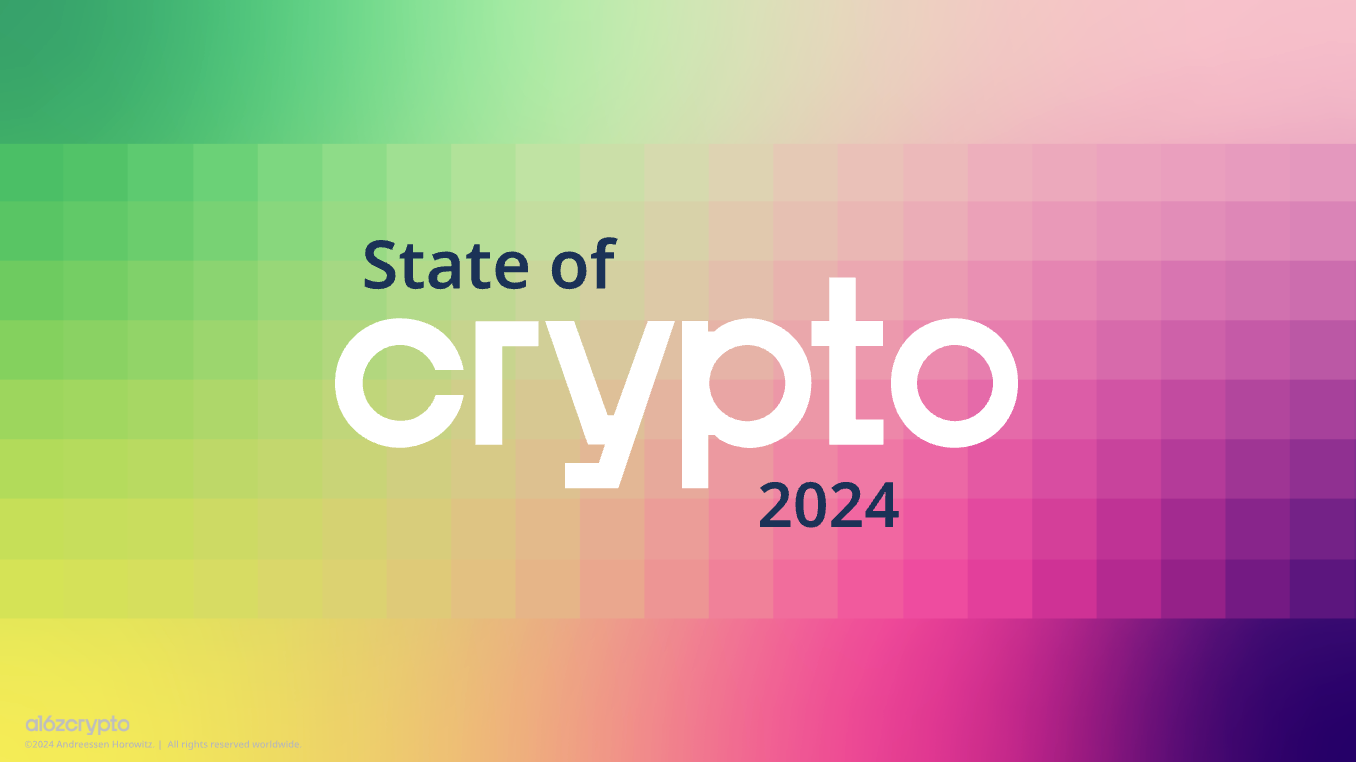
Two years ago, when we first launched our annual State of Crypto report, global attention to cryptocurrencies was still relatively low. Bitcoin and Ethereum exchange-traded products (ETPs) had not yet been approved by the U.S. Securities and Exchange Commission (SEC), and Ethereum had not yet transitioned to the energy-efficient proof-of-stake mechanism. Second-layer (L2) networks aimed at boosting transaction capacity and lowering costs were barely used, and even when they were, fees were much higher than they are today.
Now, as we release the 2024 State of Crypto report, we see a significant shift. The report delves into how cryptocurrencies have become a hot policy topic, the latest developments in blockchain technology, and new trends among crypto developers and users. The report also includes:
In-depth analysis of key applications like stablecoins, which are seen as one of the "killer apps" of cryptocurrencies;
Exploration of the convergence of cryptocurrencies with other technology trends like AI, social networks, and gaming;
New data on interest in cryptocurrencies in swing states ahead of the U.S. election, and more.
The 2024 report also shows that crypto activity has reached historic highs. It analyzes the maturation of blockchain infrastructure, particularly in the context of recent upgrades that have significantly reduced on-chain transaction costs, and the rise of Ethereum L2s and other high-throughput blockchains.
This year, we've launched a new tool: the a16z Crypto Builder Energy Dashboard. For the first time, we're sharing our unique perspective on the crypto space with the public, showcasing the distribution of "builder energy." The dashboard integrates thousands of aggregated and anonymized data points from our investment team's research, our CSX startup accelerator program, and other industry tracking tools. Through this tool, anyone can see the activity and interests of crypto builders, including the blockchains they use, the types of applications they develop, the technologies they adopt, and their geographic locations. We plan to update these data annually as part of the annual State of Crypto report.
Now, let's take a look at some of the findings from the 2024 State of Crypto report.
7 Key Takeaways:
Crypto activity and usage have reached historic highs
Crypto has become a key political issue ahead of the U.S. election
Stablecoins have found product-market fit
Infrastructure improvements have boosted capacity and dramatically lowered transaction costs
DeFi remains popular and is continuing to grow
Crypto may help solve some pressing challenges facing AI
More scalable infrastructure is enabling new on-chain applications
1. Crypto activity and usage have reached historic highs
The number of monthly active crypto addresses has reached unprecedented levels. In September, there were 220 million addresses that interacted with a blockchain at least once, more than tripling the figure from late 2023. (It's worth noting that active addresses as a metric are more easily manipulated than others. For more details, see related materials.)
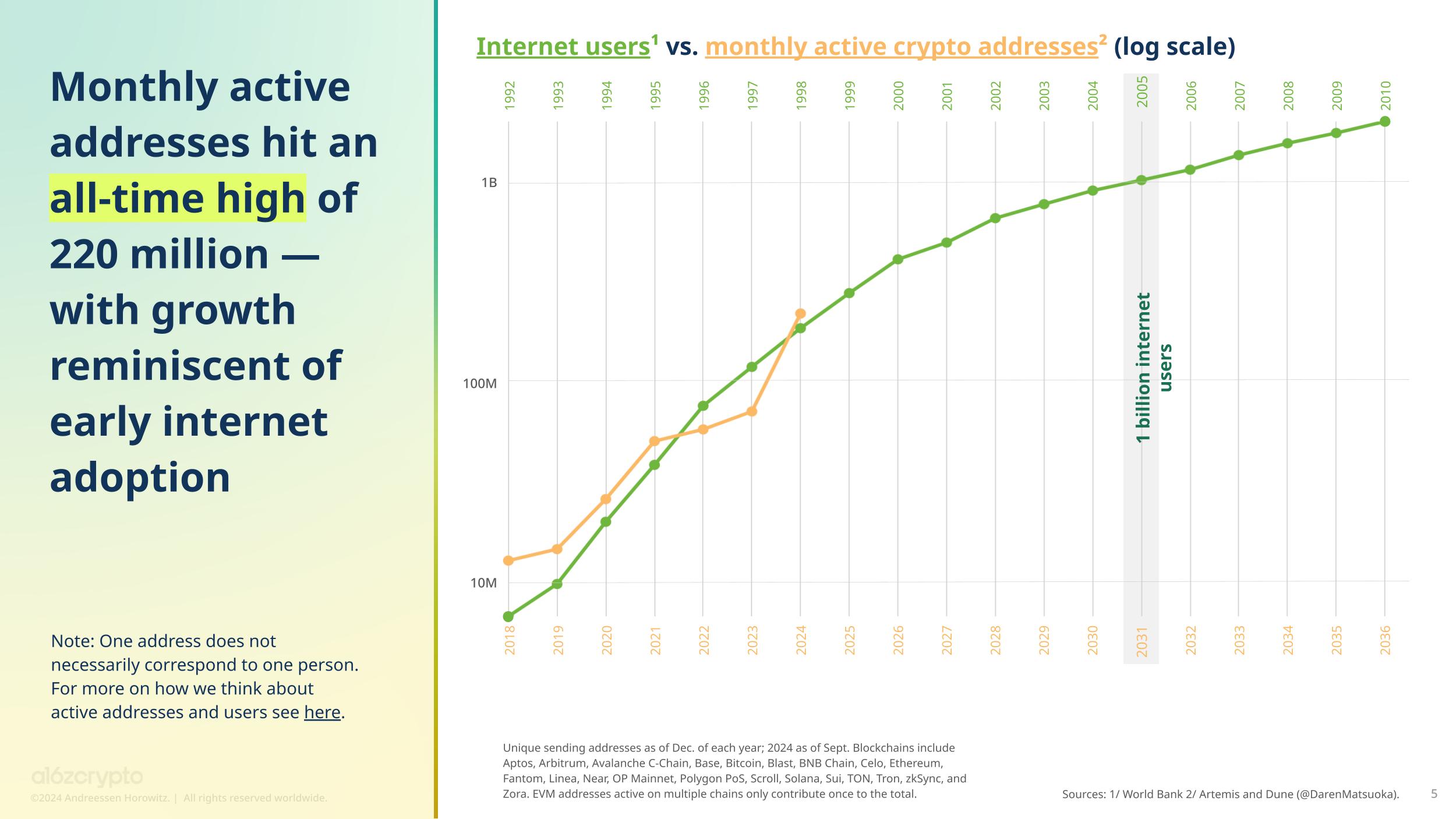
The surge in activity is largely driven by Solana, which contributed around 100 million active addresses. Following closely are NEAR (31 million active addresses), Coinbase's popular L2 network Base (22 million), TRON (14 million), and Bit (11 million). Among EVM chains, the most active after Base is Binance's BNB Chain (10 million), followed by Ethereum (6 million). (Note: The 220 million total active addresses across EVM chains is calculated after deduplicating by public key.)
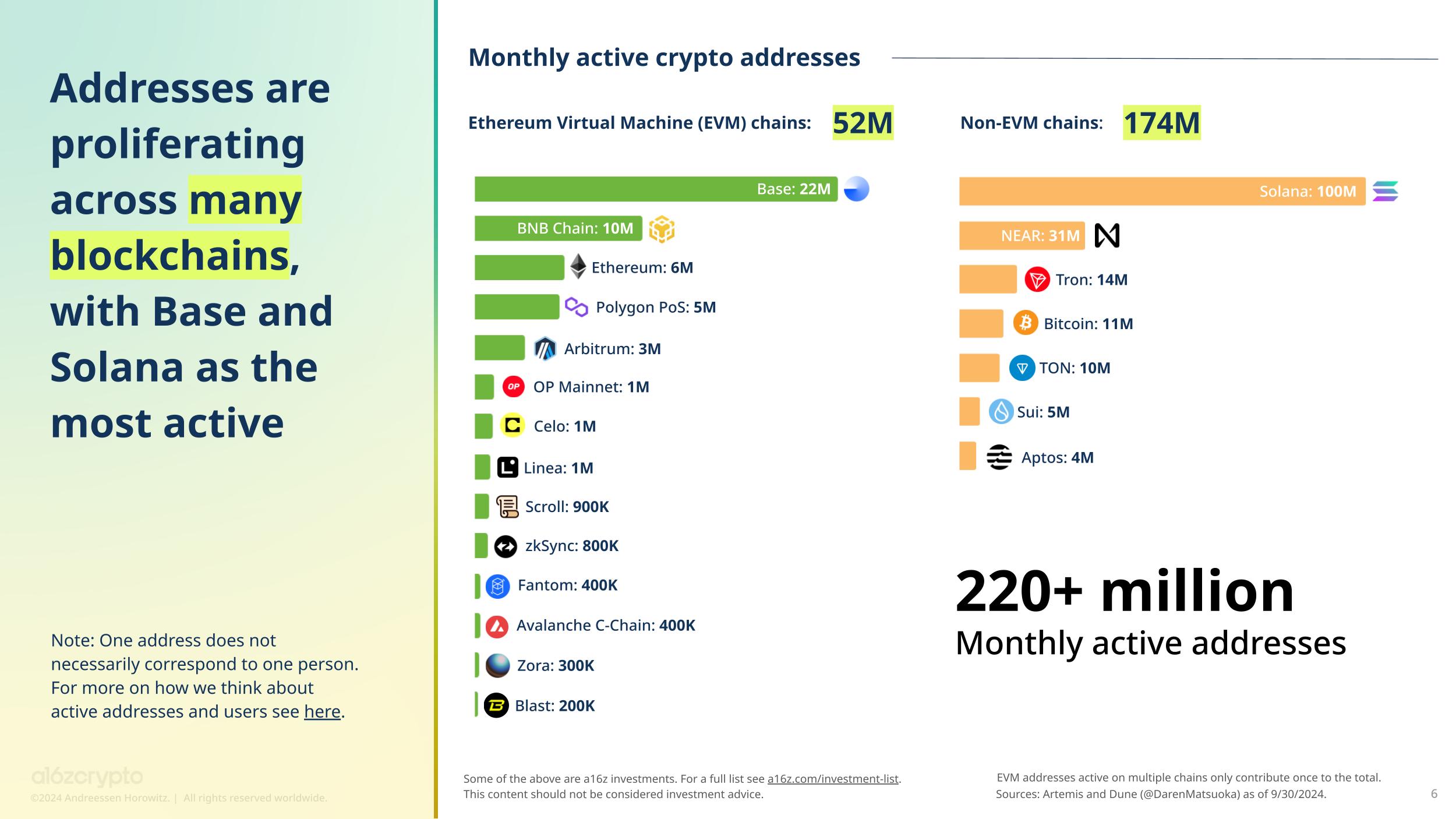
These trends are also reflected in our Builder Energy Dashboard. Solana is the blockchain that has seen the largest growth in builder interest this year. Specifically, the share of founders indicating they are or have interest in developing on Solana has increased from 5.1% last year to 11.2% this year. Base saw the second-largest growth, increasing from 7.8% last year to 10.7%, followed by Bit, which grew from 2.6% to 4.2%.
In absolute terms, Ethereum still attracts the most builder interest, accounting for 20.8%, followed by Solana and Base. Next in line are Polygon (7.9%), Optimism (6.7%), Arbitrum (6.2%), Avalanche (4.2%), and Bit (4.2%).
Meanwhile, in June 2024, the monthly active mobile crypto wallet users reached a new high of 29 million. While the U.S. accounts for the largest share of monthly mobile wallet users at 12%, the U.S. share has been declining in recent years as crypto adoption goes global and more projects exclude the U.S. to achieve compliance through geographic restrictions.
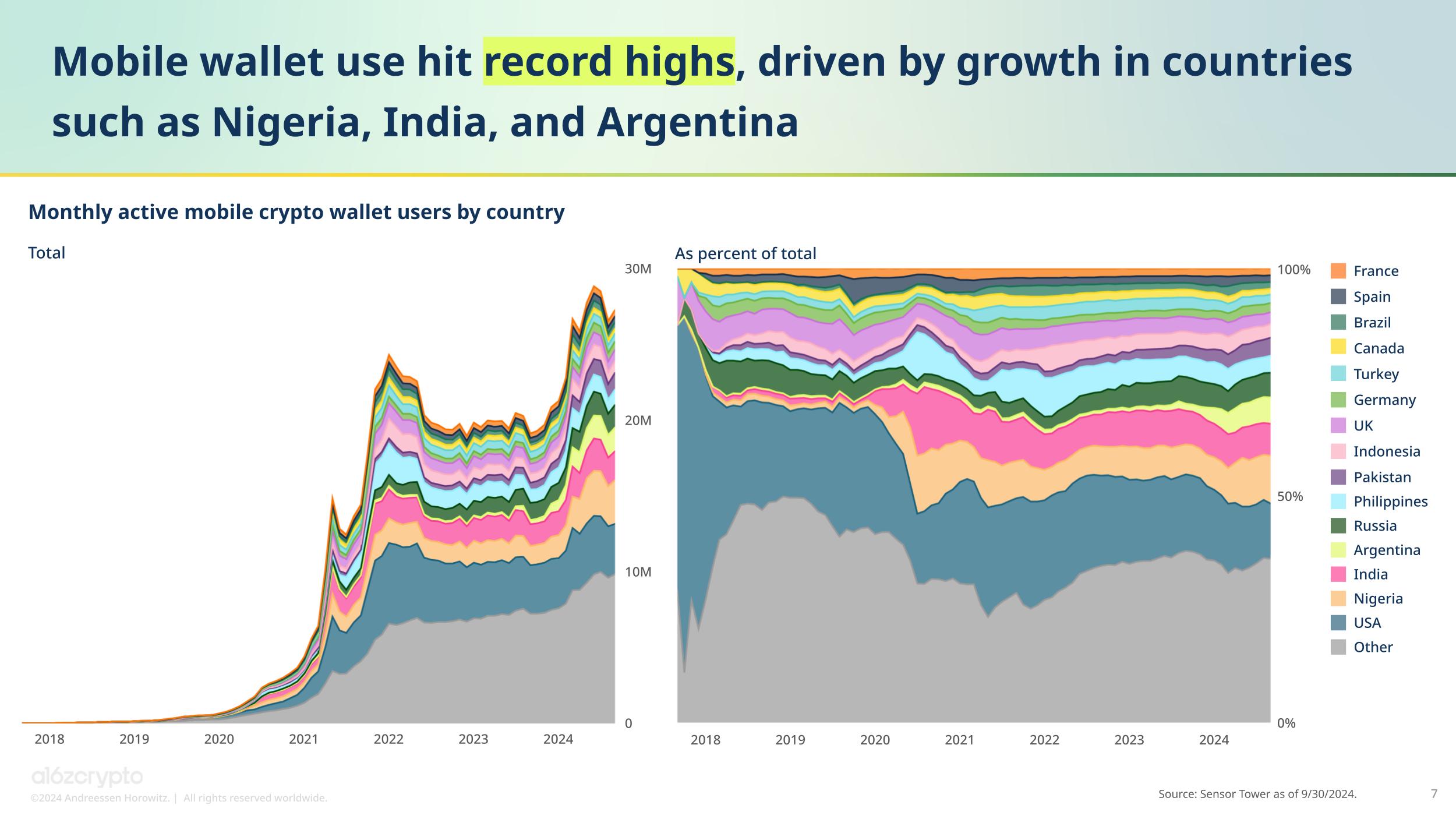
The influence of crypto is expanding globally. After the U.S., the countries with the most mobile wallet users include Nigeria (which has sought regulatory clarity through initiatives like regulatory sandboxes and has seen significant growth in bill payments and retail purchases), India (due to its large population and high smartphone penetration), and Argentina (where many residents have turned to crypto, especially stablecoins, due to currency devaluation). While the number of active addresses and monthly mobile wallet users is easy to track, the actual number of active crypto users is difficult to determine. Through various methods, we estimate the global monthly active crypto users to be around 30-60 million, which is only 5-10% of the 617 million global crypto holders estimated by Crypto.com as of June 2024. (For details on our estimation methods, see related materials.)
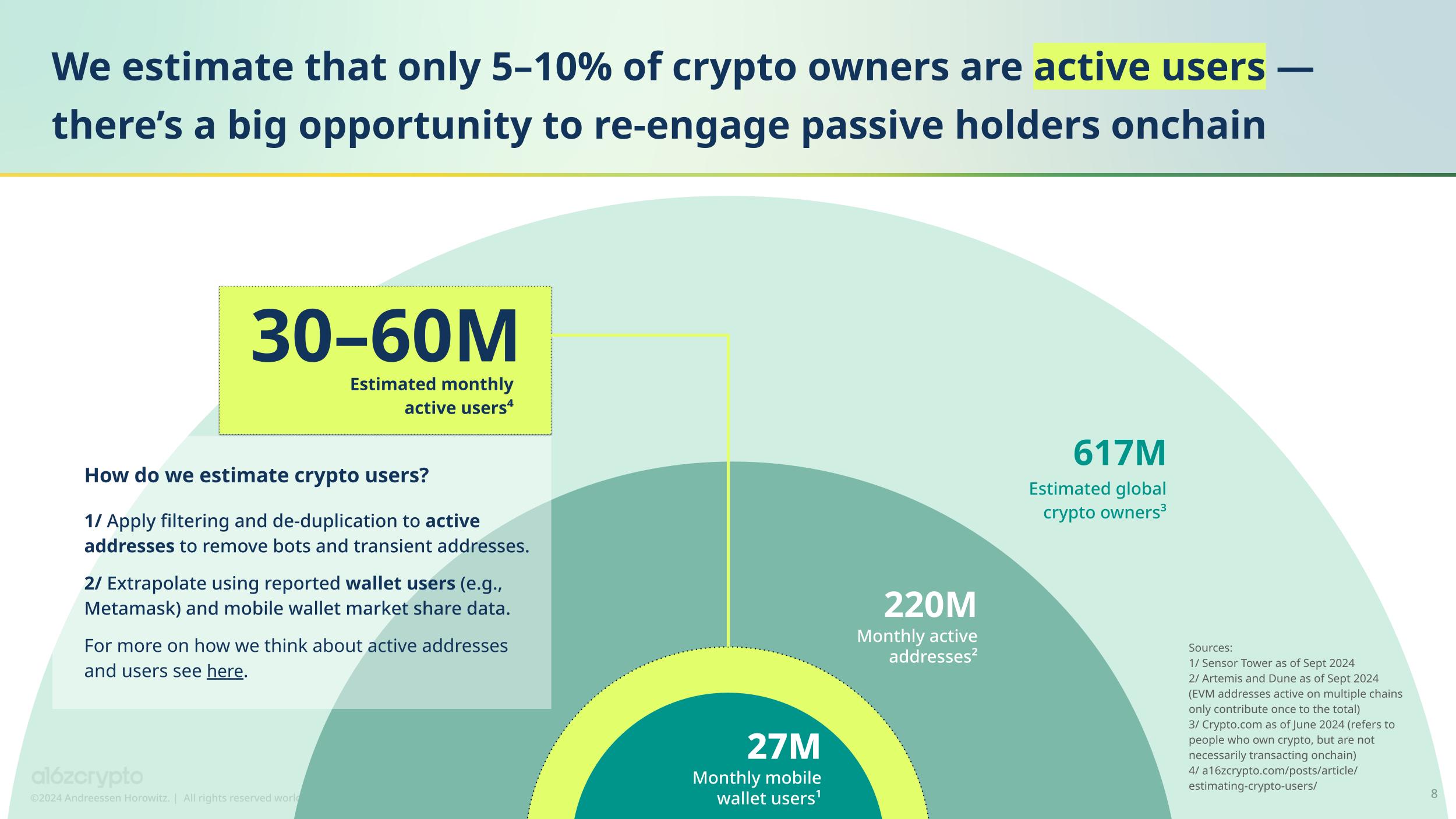
This gap suggests a huge potential to engage and re-engage passive crypto holders. As major infrastructure improvements bring entirely new, compelling applications and consumer experiences, more of the currently inactive crypto holders may convert to active on-chain users.
2. Crypto has become a key political issue ahead of the U.S. election
Crypto has emerged as one of the focal points of national discussion in this election cycle.
As a result, we measured the level of crypto interest in swing states. The two key battleground states expected to see fierce competition in November - Pennsylvania and Wisconsin - have seen their crypto-related Google Trends interest rise to the 4th and 5th positions, respectively, since the last election in 2020. Michigan ranks 8th in crypto search interest, while Georgia has remained flat. Meanwhile, Arizona and Nevada have seen their interest decline since 2020.
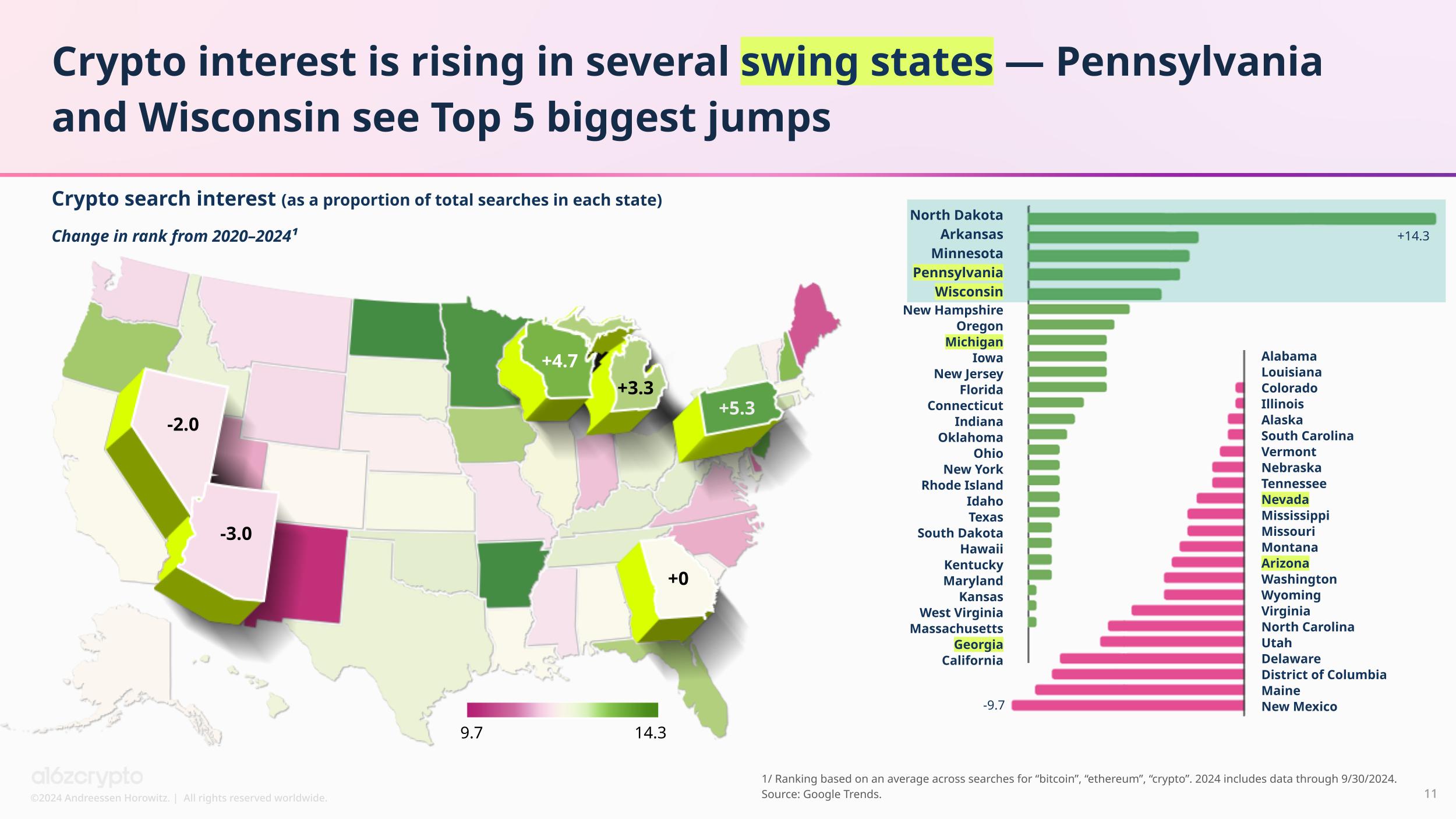
This year, the listing of Bitcoin and Ethereum exchange-traded products (ETPs) may be an important factor in increasing people's interest in cryptocurrencies. As these ETPs provide investors with a wider range of investment channels, the number of Americans holding cryptocurrencies may increase. Currently, Bitcoin and Ethereum ETPs have on-chain assets worth $65 billion. (Note: Although these products are commonly referred to as ETFs, they are actually registered as ETPs through SEC Form S-1, indicating that their underlying asset portfolios do not contain securities.)
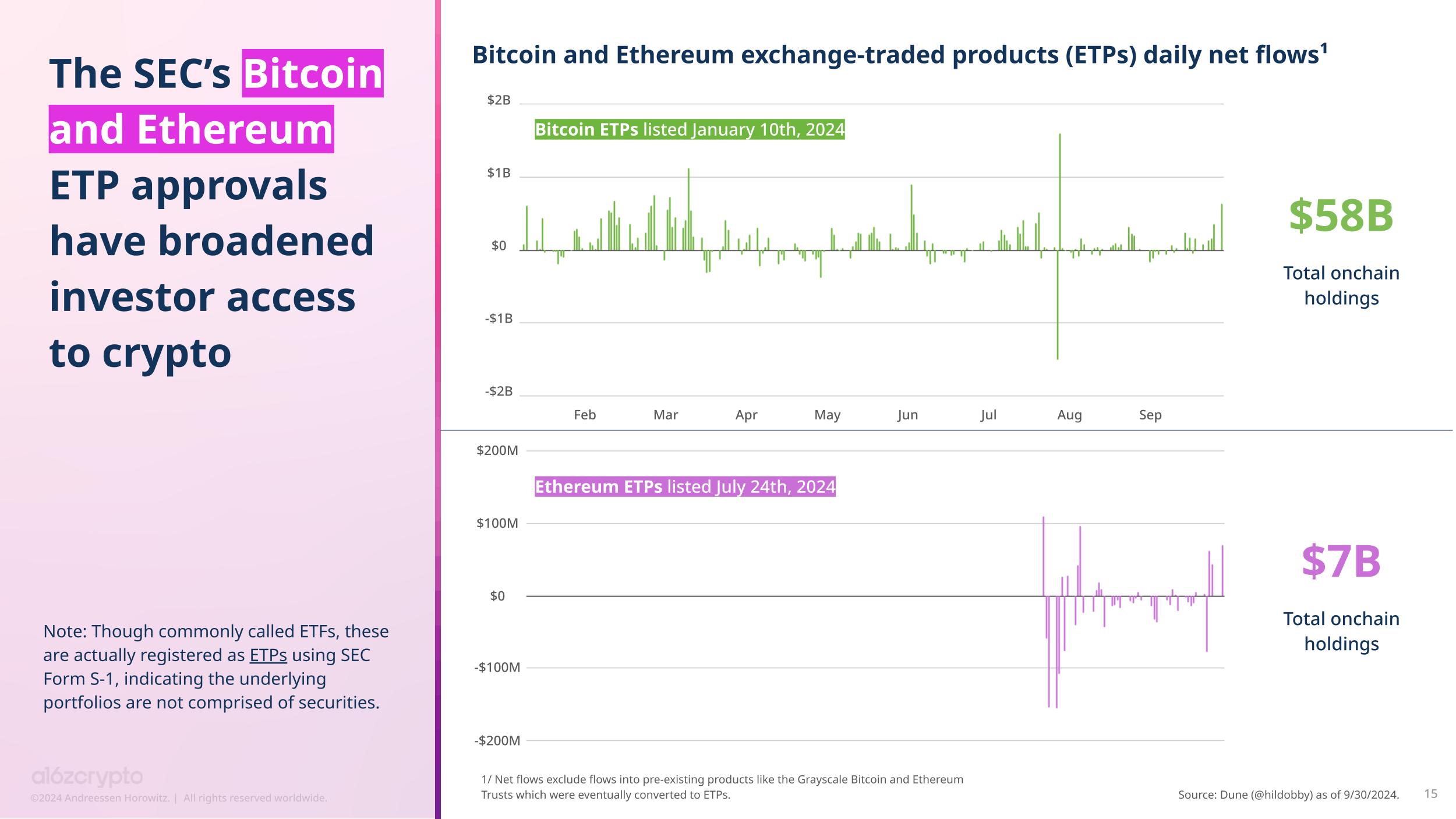
The SEC's approval of ETPs marks a significant progress in crypto policy. Regardless of which party wins the election in November, many politicians expect that bipartisan crypto legislation will further drive this trend. More and more policymakers and politicians in both parties have a positive attitude towards cryptocurrencies.
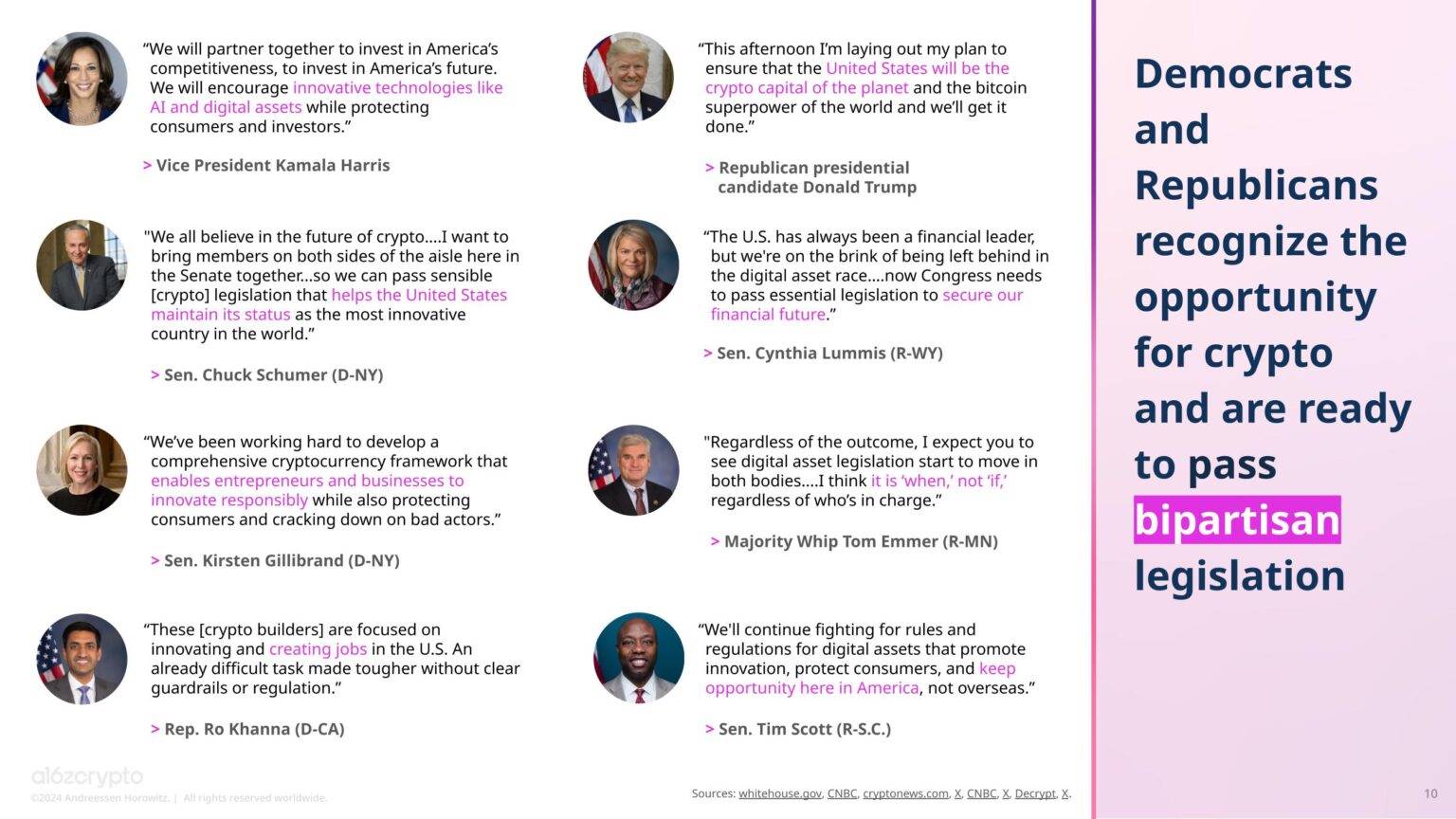
This year, the industry has also made other important progress in policy. At the federal level, the House of Representatives passed the Financial Innovation and Technology (FIT21) Act with bipartisan support, with 208 Republicans and 71 Democrats voting in favor. If passed by the Senate, this bill could provide the much-needed regulatory clarity for crypto entrepreneurs.
Equally important, at the state level, Wyoming passed the Decentralized Autonomous Organization Nonprofit Act (DUNA), which grants legal status to decentralized autonomous organizations (DAOs) and allows blockchain networks to operate legally without affecting decentralization.
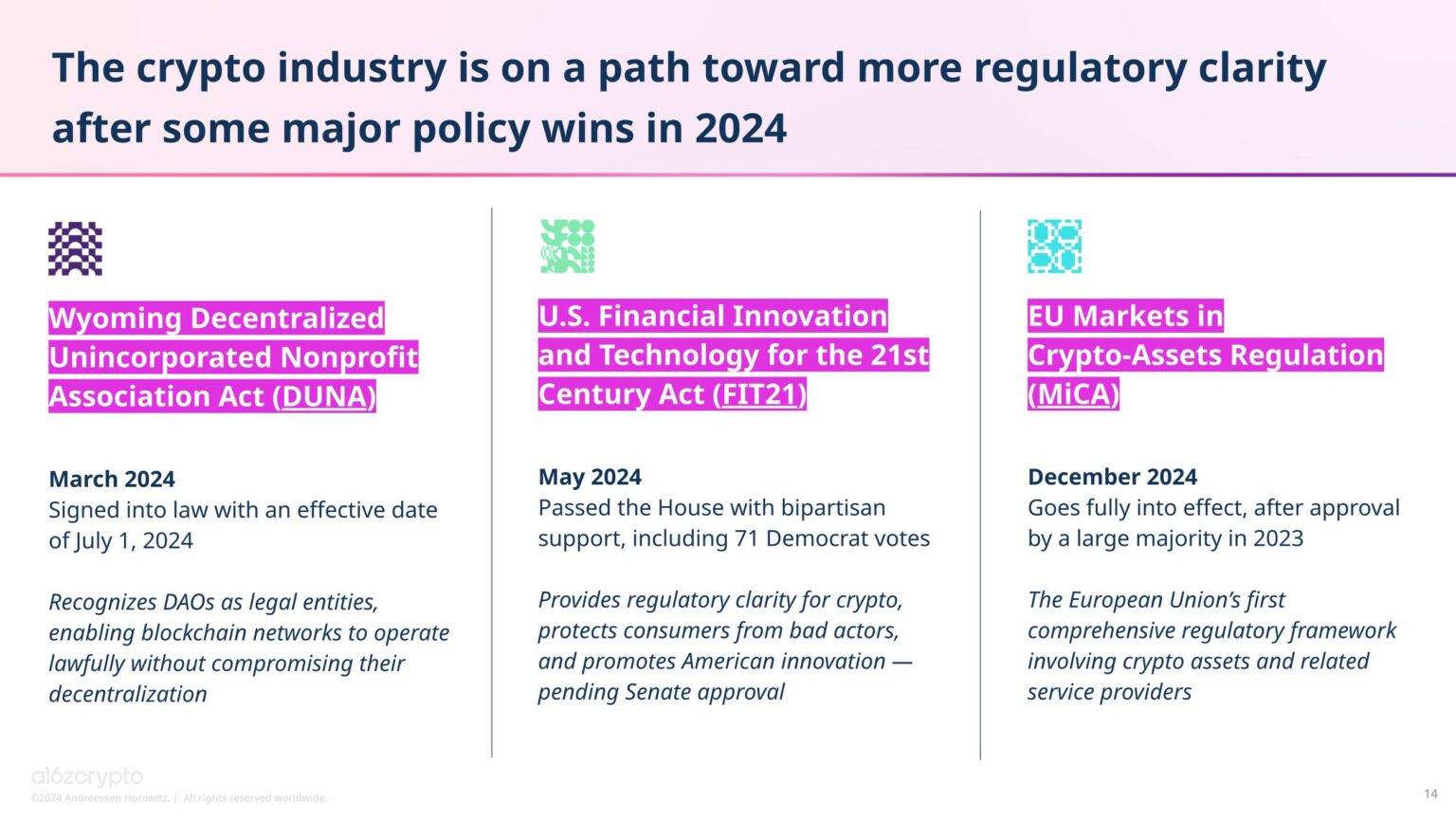
The European Union and the United Kingdom have been the most proactive in engaging the public on cryptocurrency policy and regulation. In comparison, various European institutions have issued more consultation papers than the U.S. Securities and Exchange Commission. At the same time, the EU's Markets in Crypto-Assets (MiCA) regulation has become the first comprehensive crypto policy framework to be enacted through legislation, expected to be fully implemented by the end of the year.
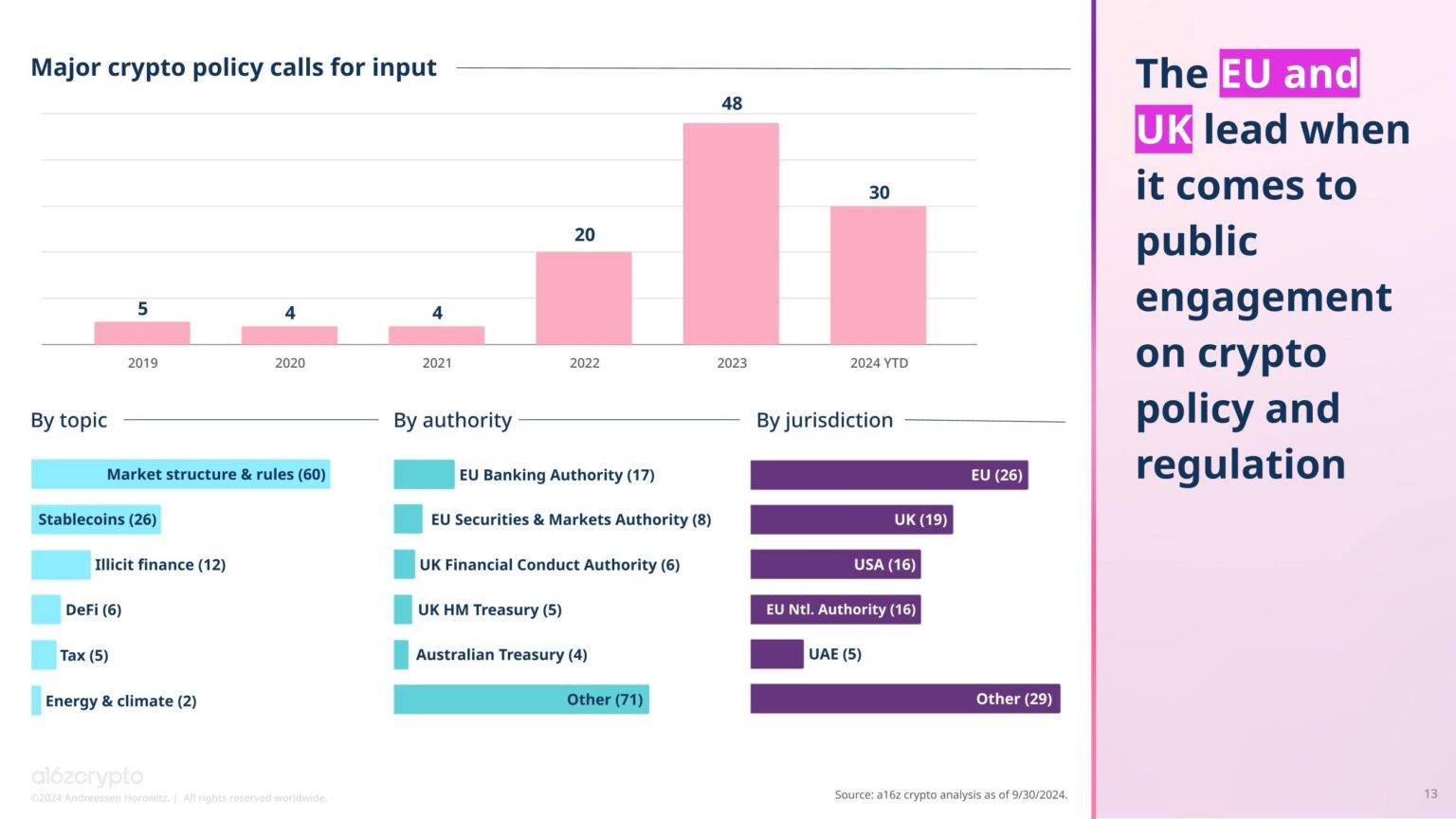
Stablecoins, as one of the most popular crypto products currently, have been a hot topic of policy discussion, with multiple related bills being discussed in the U.S. Congress. In the U.S., one of the factors driving this discussion is the recognition that stablecoins can still strengthen the dollar's influence internationally even as the dollar's status as the global reserve currency declines. Currently, over 99% of stablecoins are denominated in U.S. dollars, far exceeding the second-largest denomination currency: the Euro, which accounts for only 0.20%.
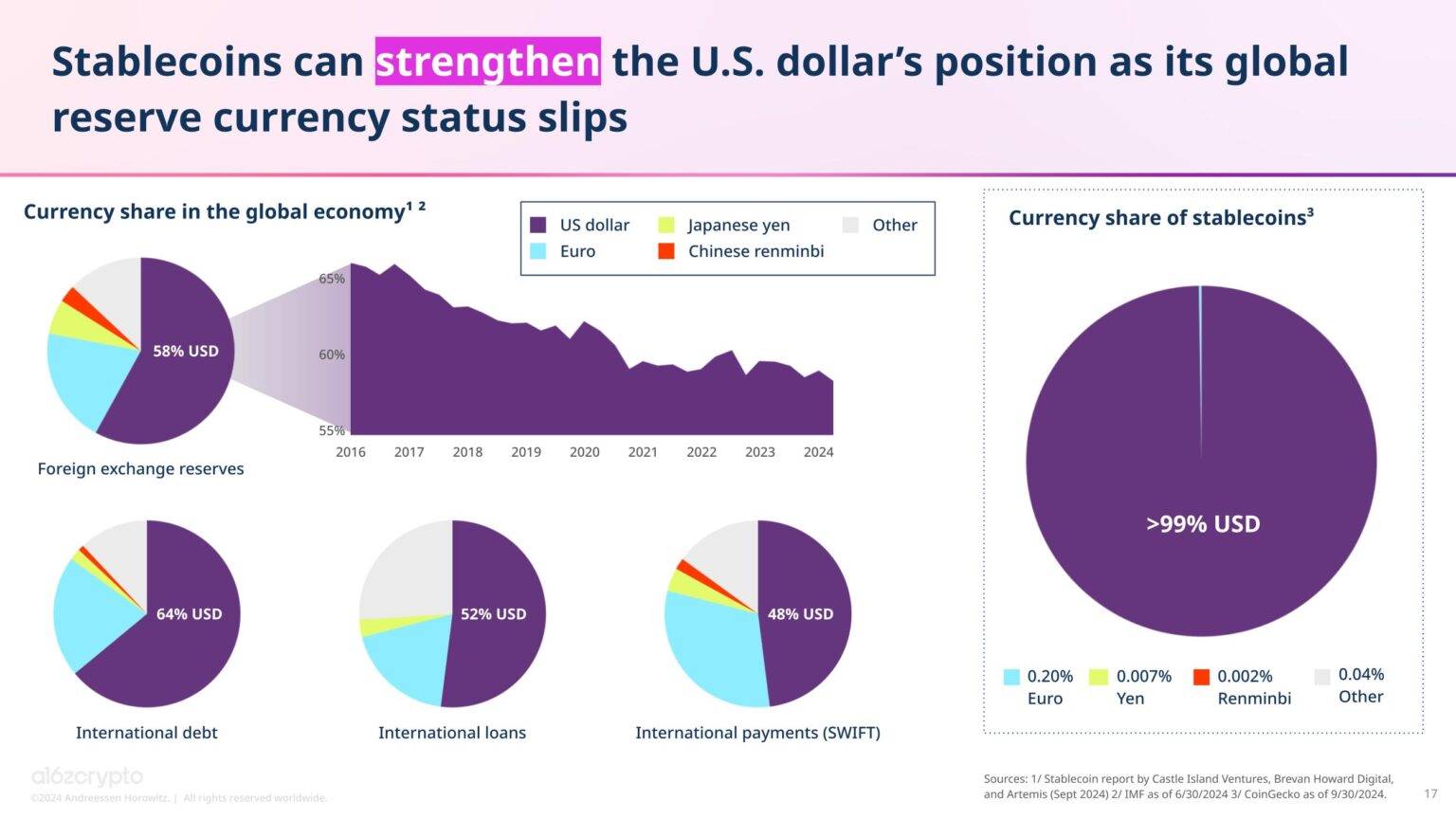
In addition to strengthening the dollar's influence internationally, stablecoins may also reinforce the U.S. financial infrastructure domestically. Although stablecoin development is only a decade old, they have already become one of the top 20 holders of U.S. Treasuries, surpassing many other countries like Germany.
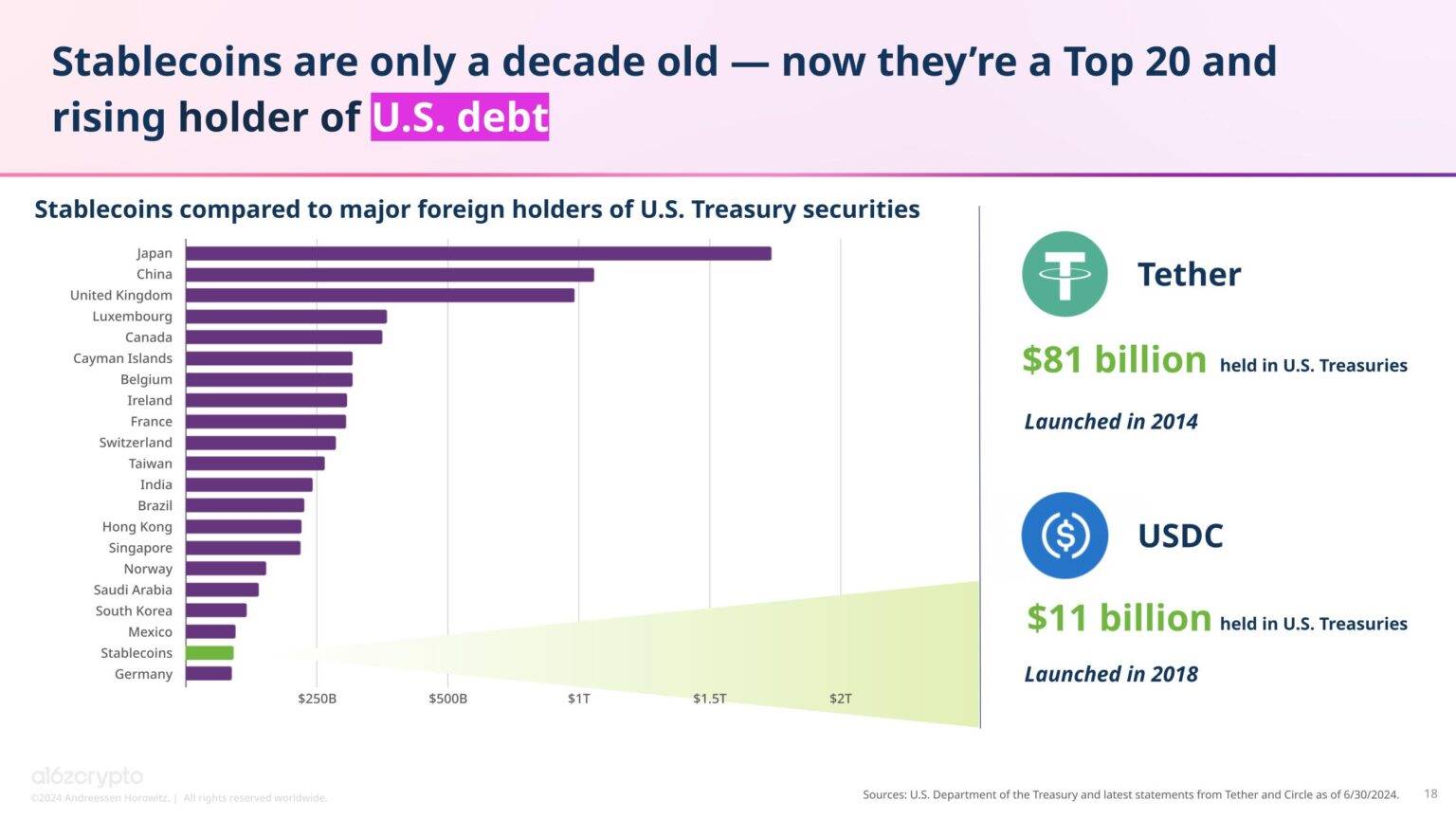
While some countries are exploring central bank digital currencies (CBDCs), the stablecoin opportunity in front of the U.S. has already matured. Against the backdrop of these discussions and the increasing number of prominent political figures weighing in on cryptocurrencies, we expect more countries to start seriously formulating their crypto policies and strategies.
3. Stablecoins Have Found Product-Market Fit
Stablecoins have become one of the most attractive "killer apps" in the cryptocurrency space due to their fast, low-cost global payment functionality. As Congressman Ritchie Torres stated in his September op-ed in the New York Daily News, "The widespread use of dollar-pegged stablecoins - enabled by the ubiquity of smartphones and the cryptographic technology of blockchains - may be the greatest financial empowerment experiment in human history."
Through major scaling upgrades, the cost of executing crypto transactions, especially stablecoin transactions, has been dramatically reduced, in some cases by over 99%. On the Ethereum network, the average transaction fee for using USDC (a popular dollar-pegged stablecoin) has dropped from $12 in 2021 to $1 this month. On Coinbase's popular L2 network Base, the average cost to send USDC is less than a penny.
Compared to the average $44 cost of international wire transfers, stablecoin fees are extremely low.
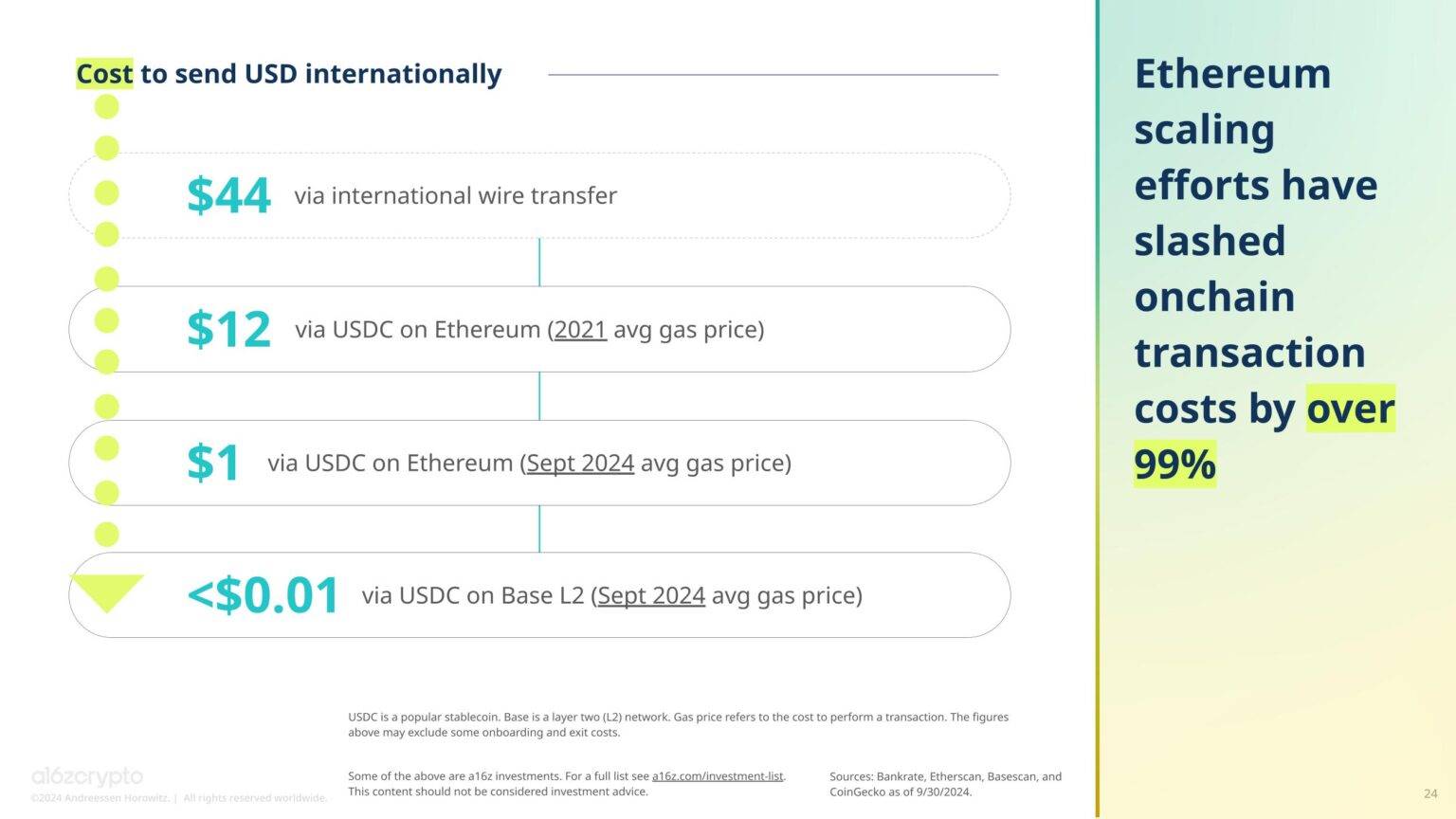
Stablecoins have greatly simplified value transfer. In Q2 2024, stablecoin transaction volume reached $85 trillion, involving 1.1 billion transactions. This transaction volume is more than double Visa's $39 trillion in the same period. Stablecoins can compete with well-known payment services like Visa, PayPal, ACH, and Fedwire, demonstrating their utility.
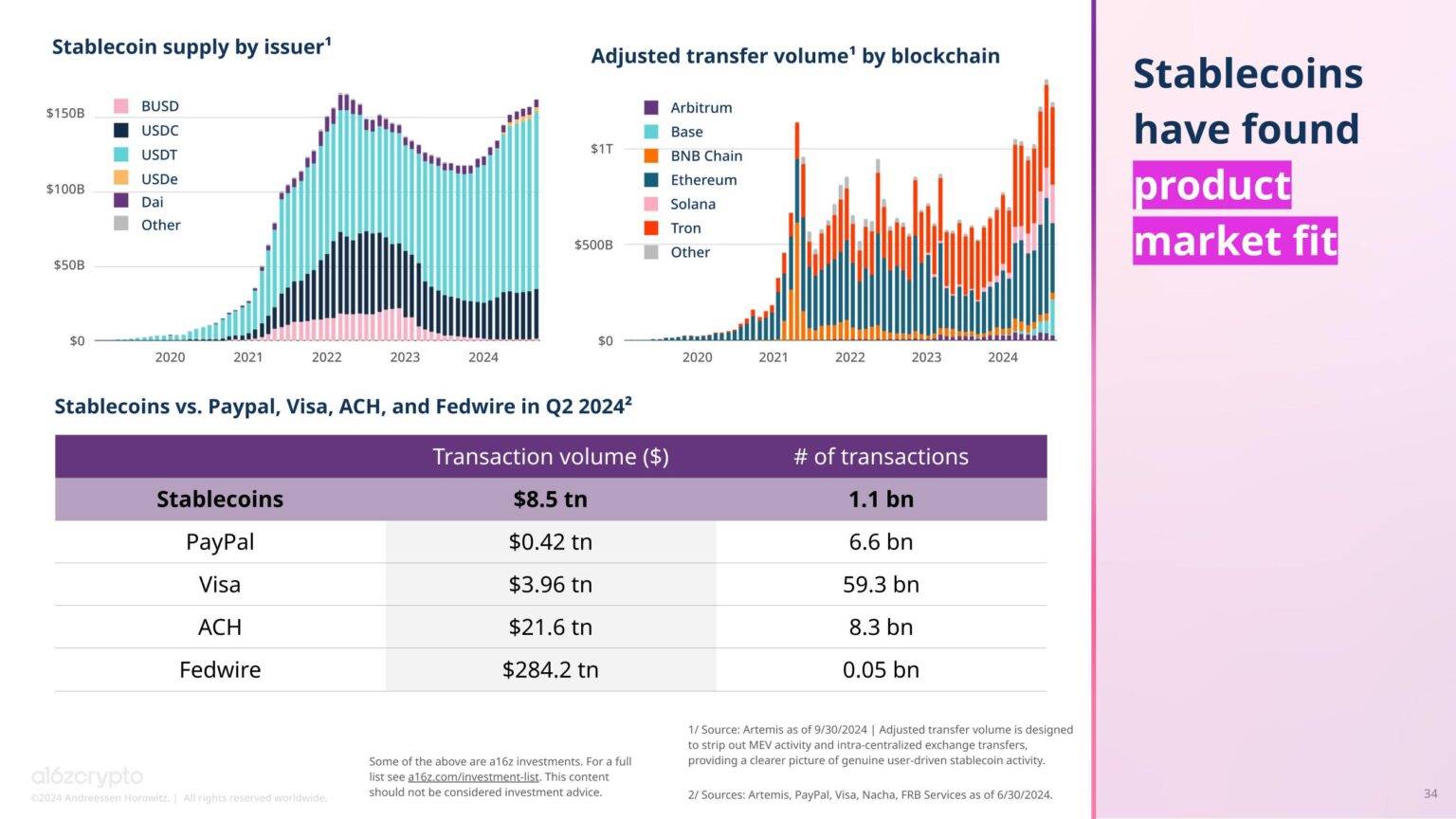
Stablecoins are not just a passing trend. Even during periods of crypto market volatility, stablecoin usage does not appear to be strongly correlated with market cycles. In fact, the monthly number of sending addresses for stablecoins continues to increase, even as spot crypto trading volumes decline. In other words, people are using stablecoins for purposes beyond just trading.
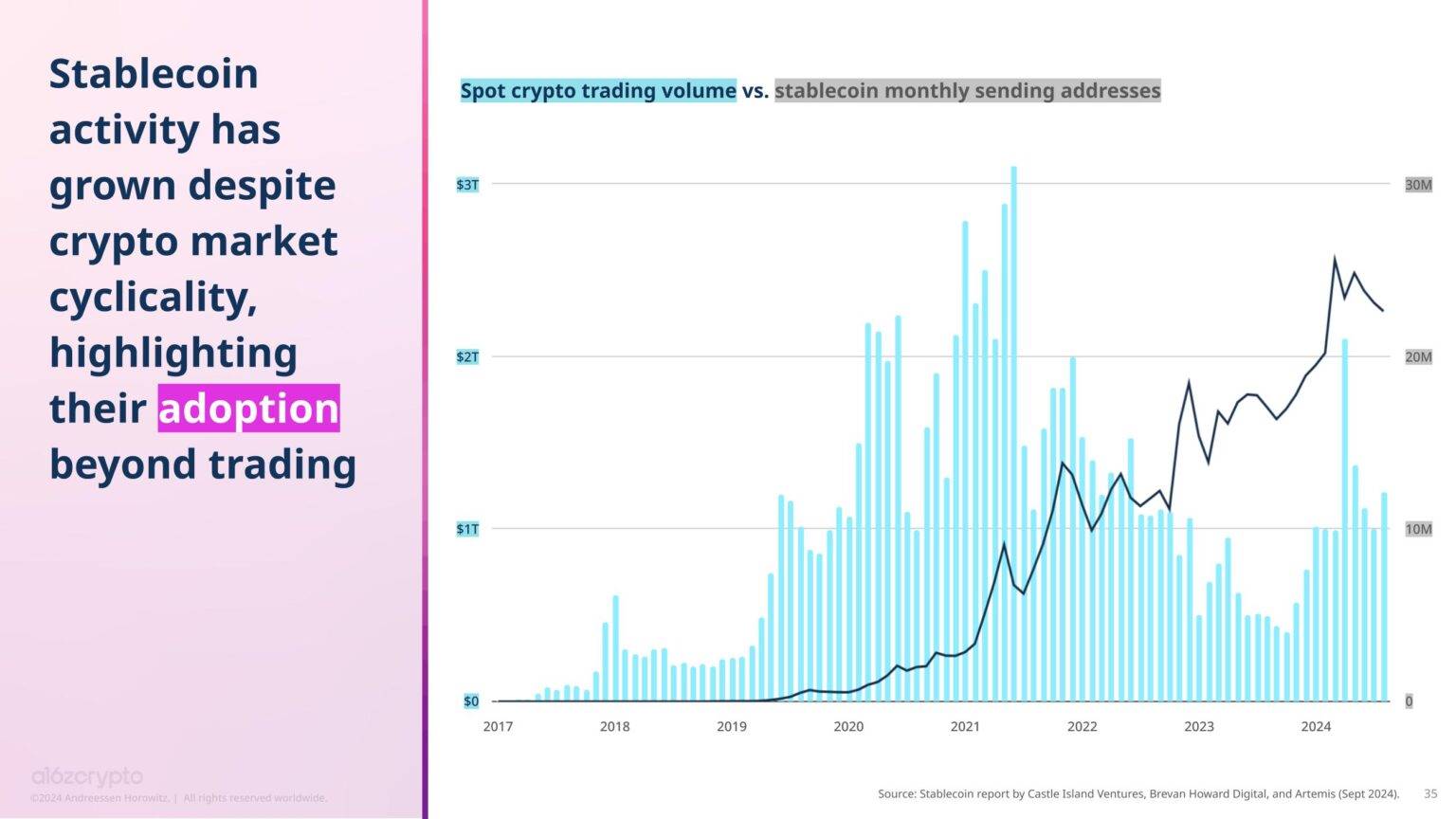
All this activity is reflected in the usage statistics. Stablecoins account for nearly a third, or 32%, of daily cryptocurrency usage, second only to decentralized finance (DeFi) at 34%, as measured by the proportion of daily active addresses. The remaining cryptocurrency usage is distributed across infrastructure (such as bridges, oracles, maximum extractable value, account abstraction, etc.), token transfers, and other emerging applications like gaming, Non-Fungible Tokens, and social networks.
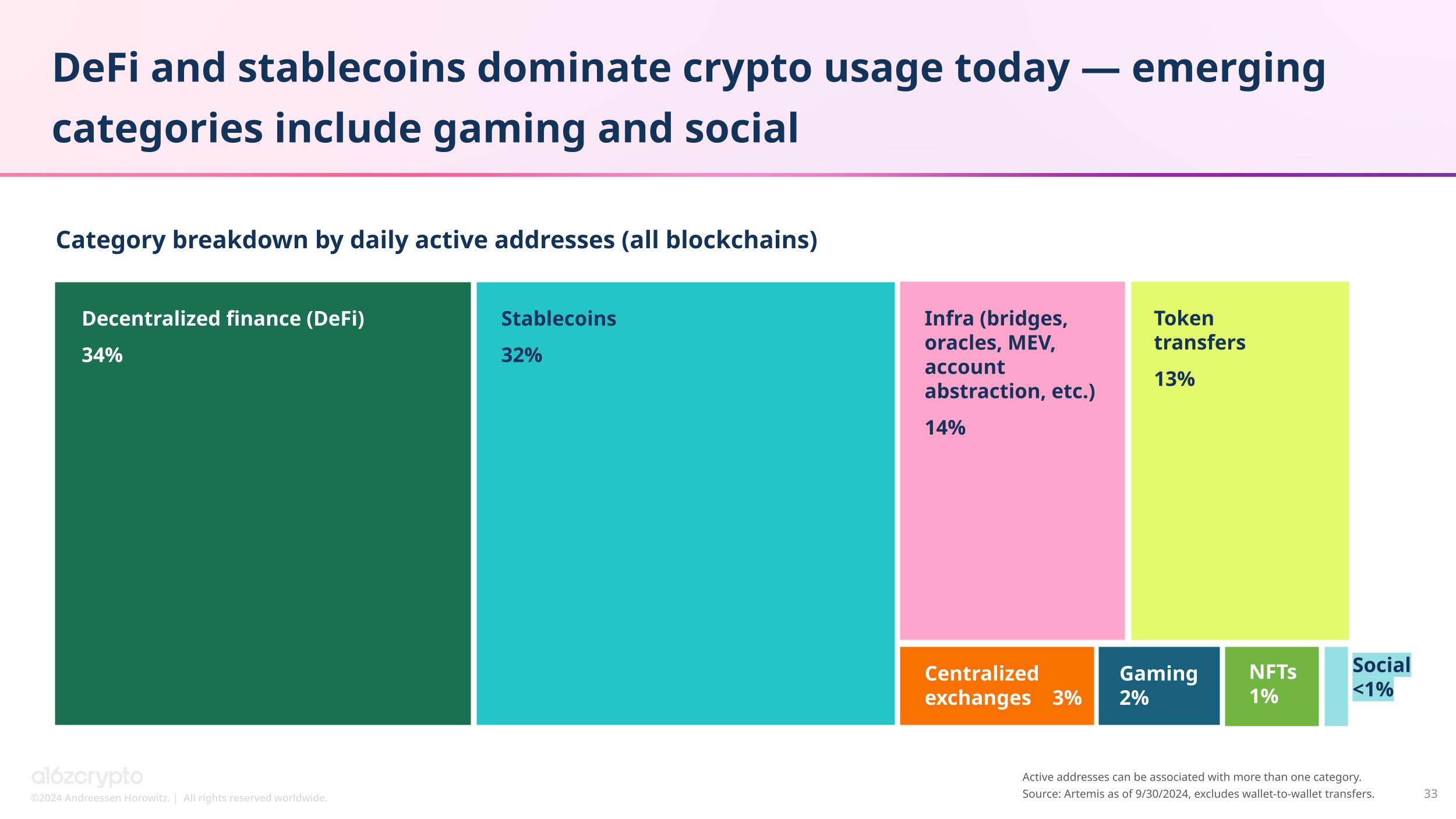
4. Infrastructure Improvements Have Increased Capacity and Significantly Reduced Transaction Costs
One of the reasons stablecoins are so popular and easy to use is the progress made in the underlying infrastructure. First, blockchain processing capacity has been steadily increasing. Thanks to the rise of Ethereum L2 networks and other high-throughput blockchains, the number of transactions processed per second is now over 50 times what it was four years ago.
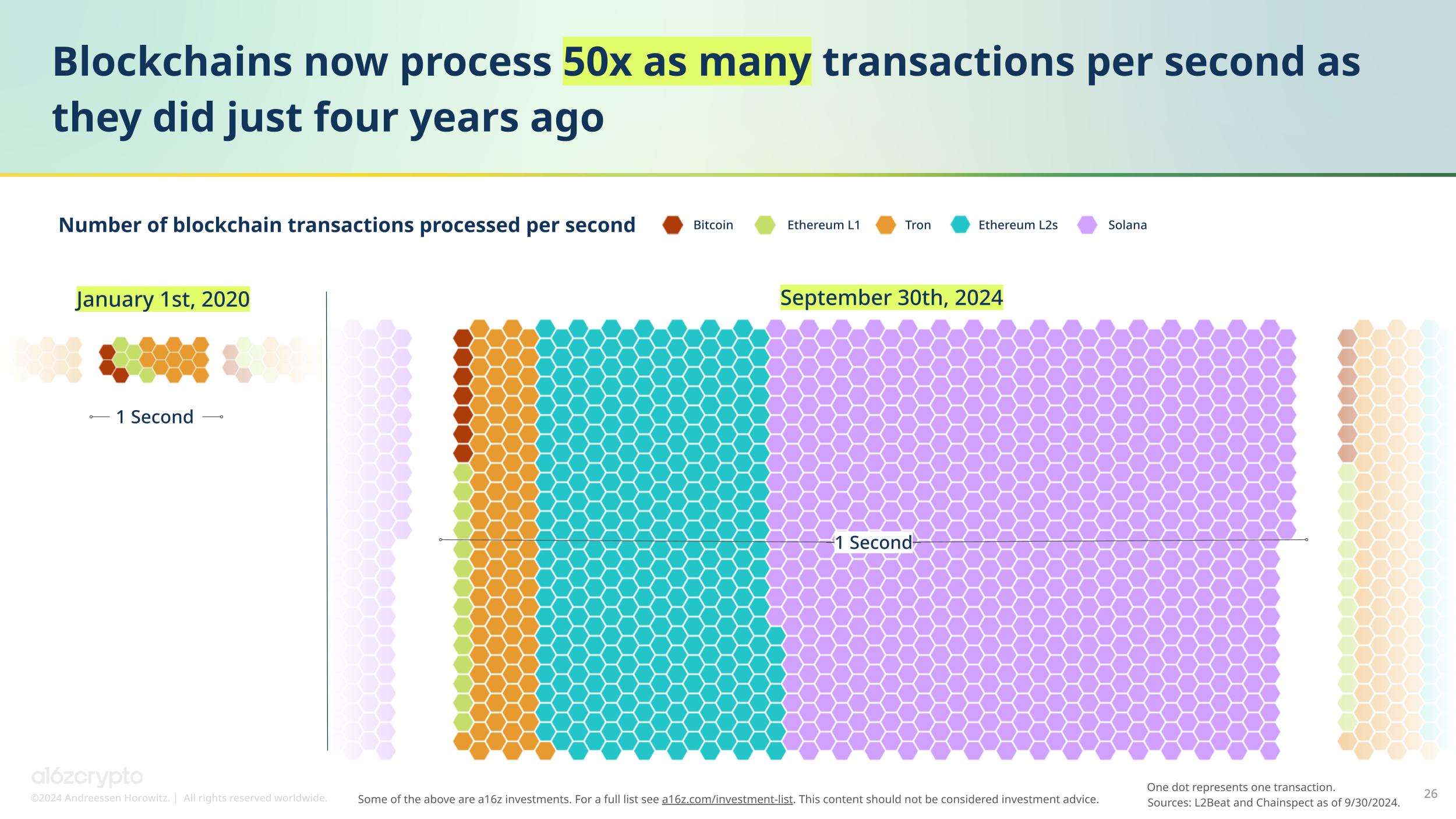
Even more surprisingly, Ethereum's major annual upgrade in March 2024, known as Dencun, also referred to as "protodanksharding" or EIP-4844, has significantly reduced the costs of L2 networks. Since then, even as the value locked on L2s has continued to grow, the fees paid on Ethereum have dropped dramatically. In other words, blockchain networks are becoming increasingly popular while also becoming more efficient.
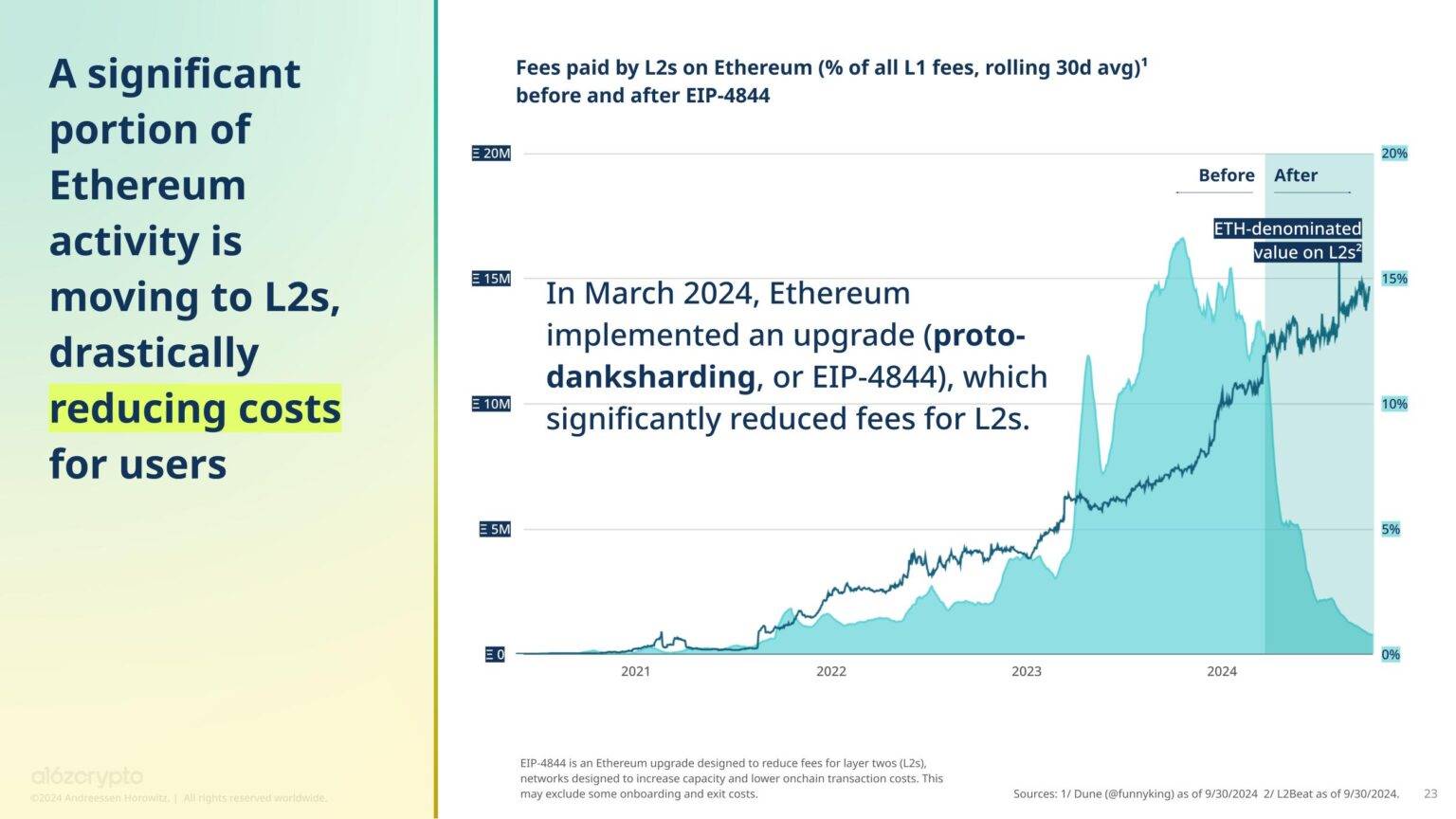
Zero-knowledge (ZK) proofs have also seen similar trends, with this technology having a significant impact on the scalability, privacy, and interoperability of blockchains. Even as the monthly fees used to verify ZK proofs on Ethereum have decreased, the value of Ethereum locked in ZK rollups has been growing. In other words, the costs of ZK proofs are also declining while their adoption is increasing. (Here we use zero-knowledge as an umbrella term for the cryptographic techniques that can concisely prove the correctness of computations executed on rollup networks.)
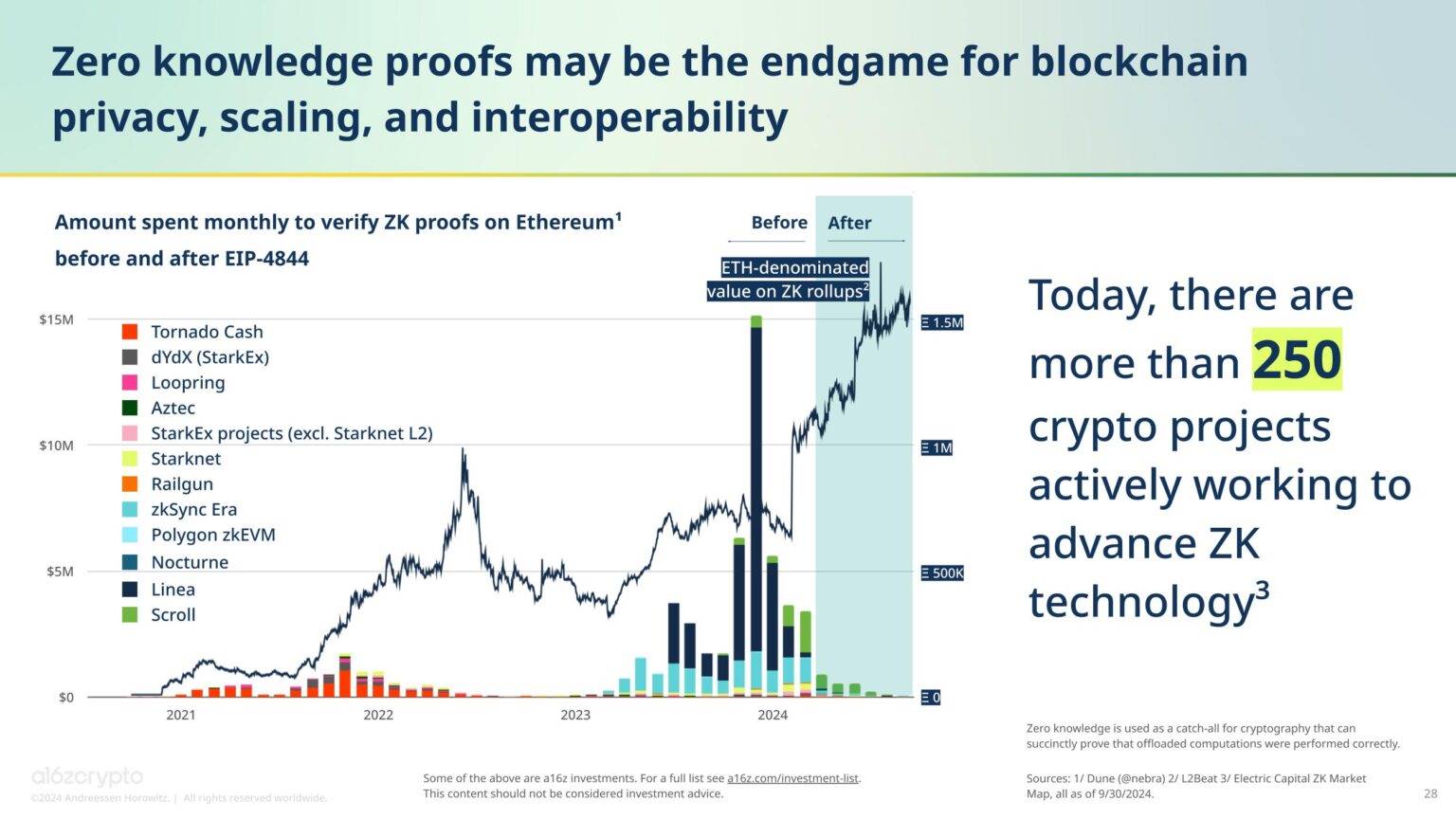
ZK technology has a broad prospect, providing developers with a new path to affordable and verifiable blockchain computing. However, zk-based virtual machines (zkVMs) still need to work hard to catch up with traditional computers in terms of performance - this is a humble observation worth noting.
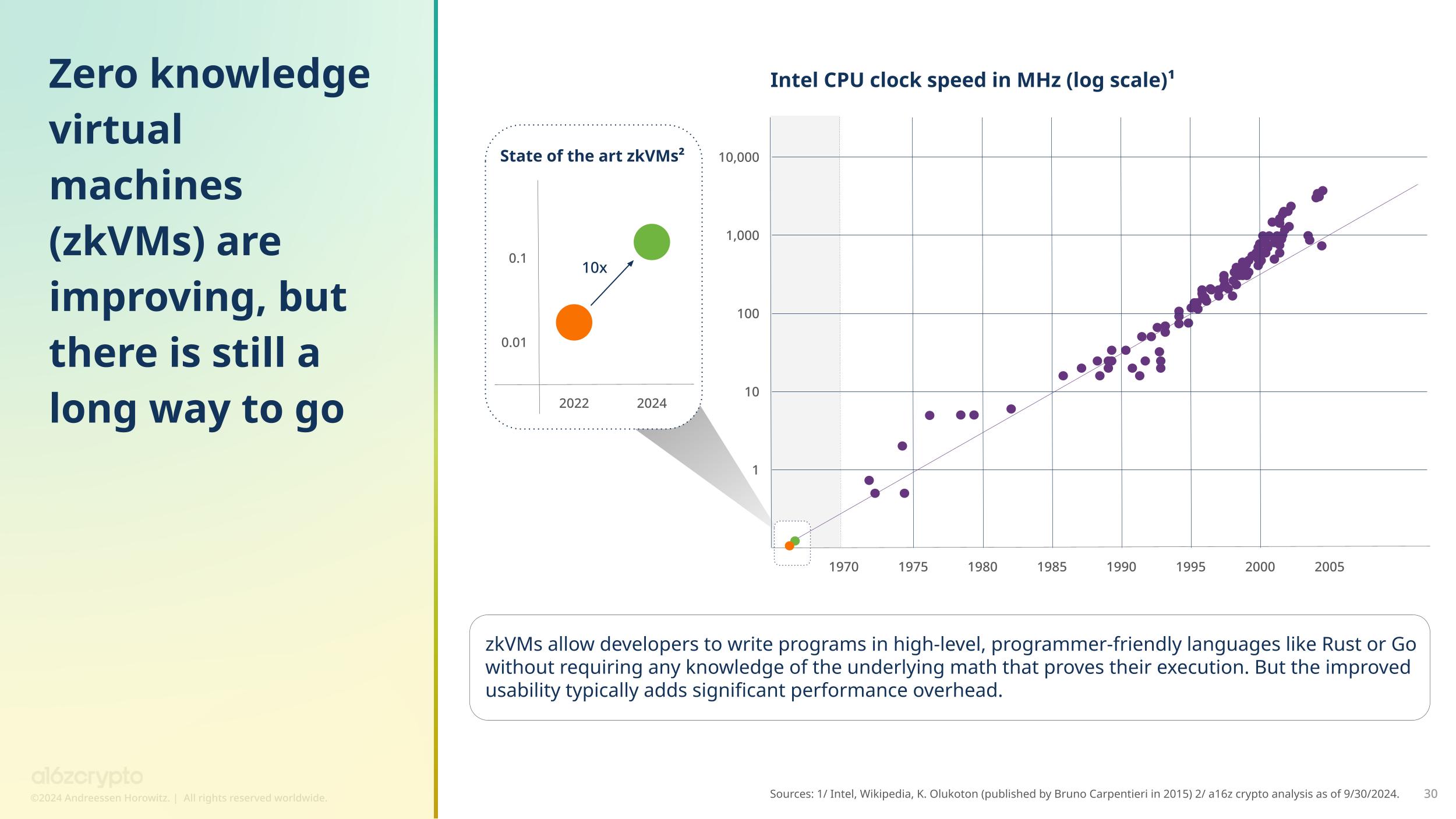
As these infrastructures improve, we can easily understand why blockchain infrastructure remains one of the most popular areas for developers, and why L2 has become one of the five hottest development subcategories we are tracking.
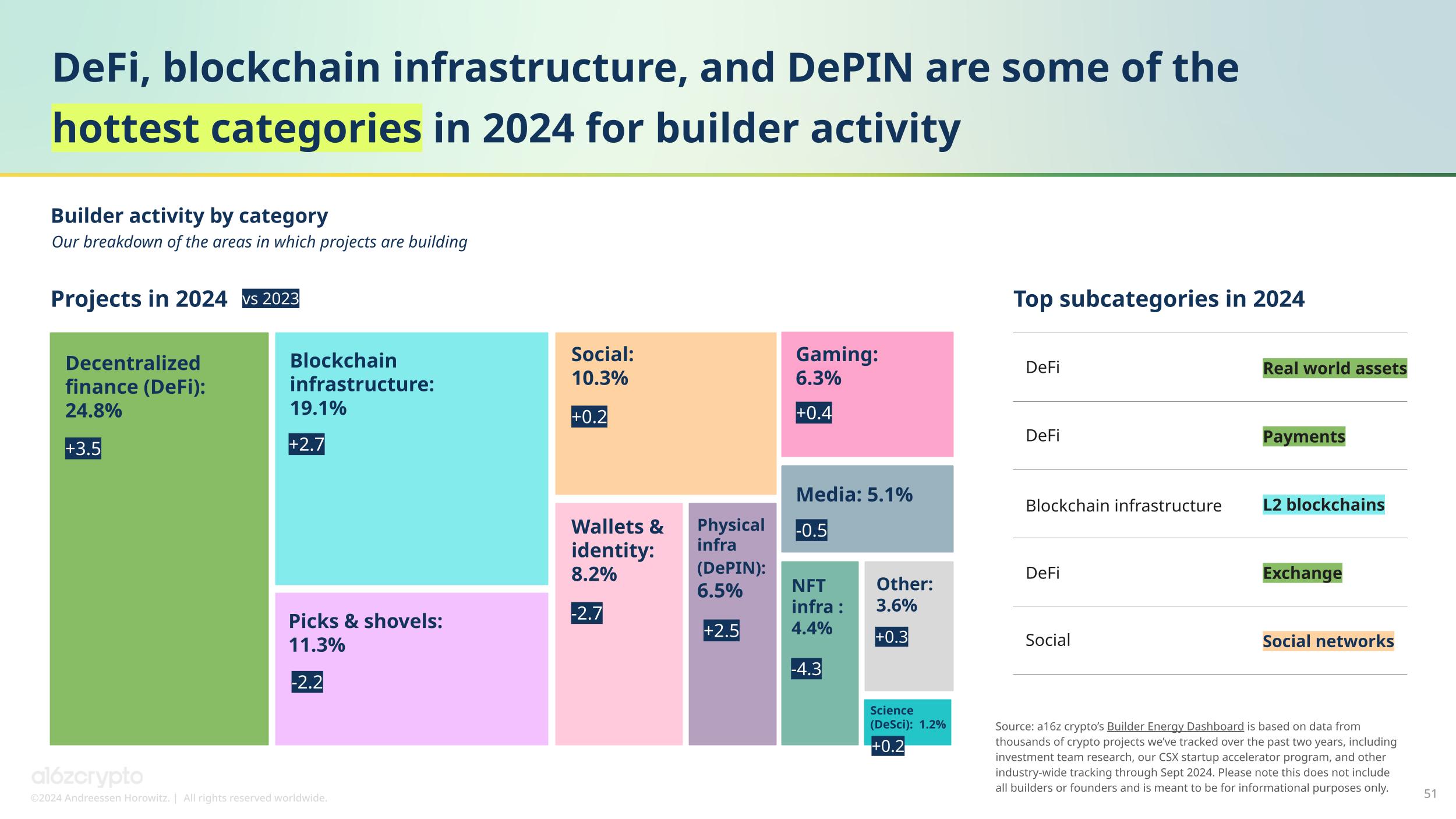
5. DeFi remains popular and continues to grow
The only area more attractive to developers than blockchain infrastructure is decentralized finance (DeFi), which also accounts for the largest share of cryptocurrency usage, with 34% of daily active addresses related to DeFi. Since the DeFi boom in the summer of 2020, decentralized exchanges (DEXs) have grown to account for 10% of spot cryptocurrency trading activity, which was all done on centralized exchanges four years ago.
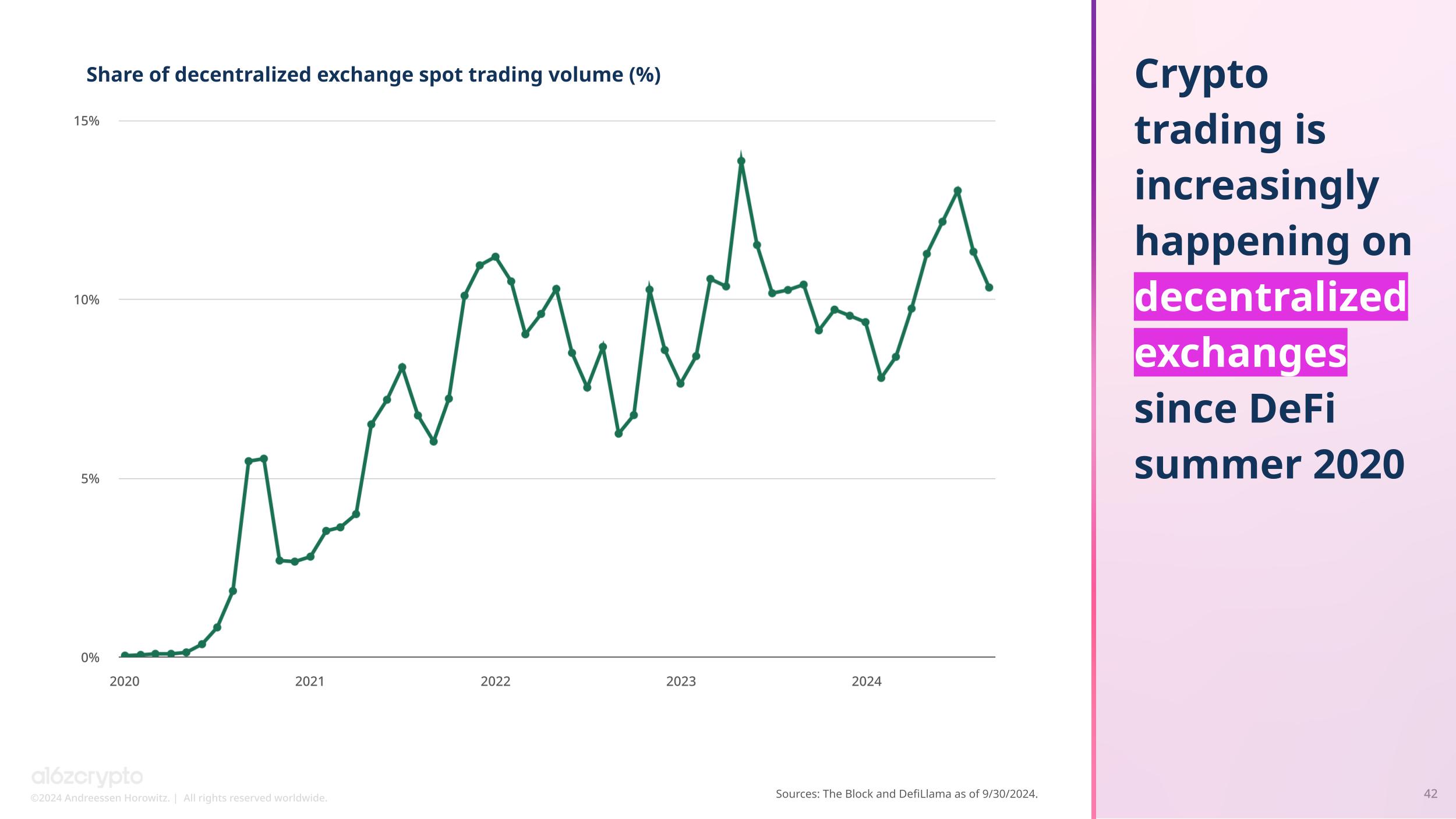
Currently, over $169 billion in funds are locked in thousands of DeFi protocols. Staking and lending are some of the major DeFi subcategories.
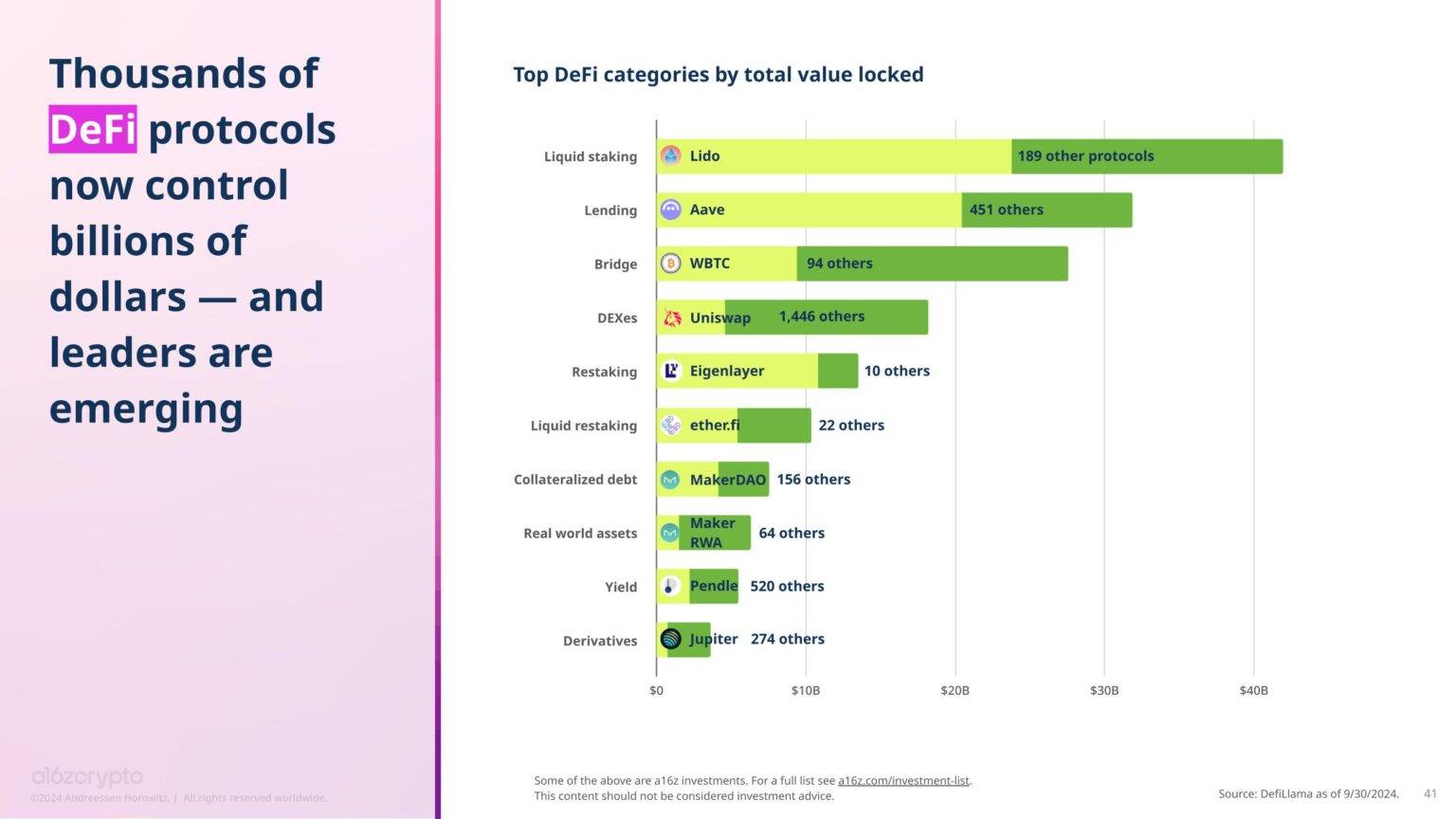
It has been over two years since Ethereum completed the transition to a proof-of-stake mechanism, significantly reducing the network's energy consumption and environmental impact. Since then, Ethereum's staking ratio has risen from 11% two years ago to 29%, greatly enhancing the network's security.
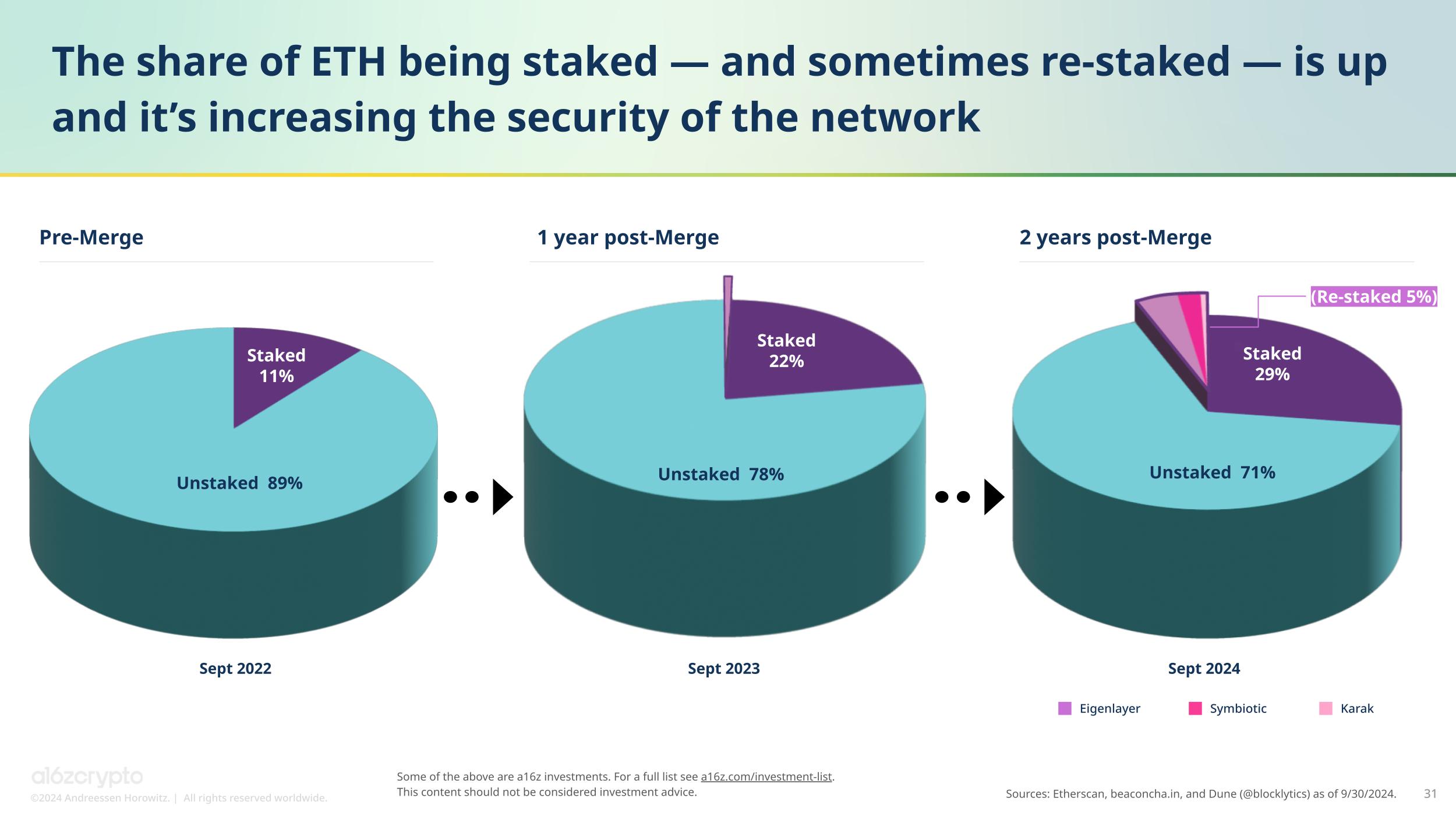
Although still in its early stages, DeFi provides a viable alternative to the growing centralization and concentration of power in the U.S. financial system. The number of banks in the U.S. has decreased by two-thirds since 1990, with assets increasingly concentrated in a few large banks.
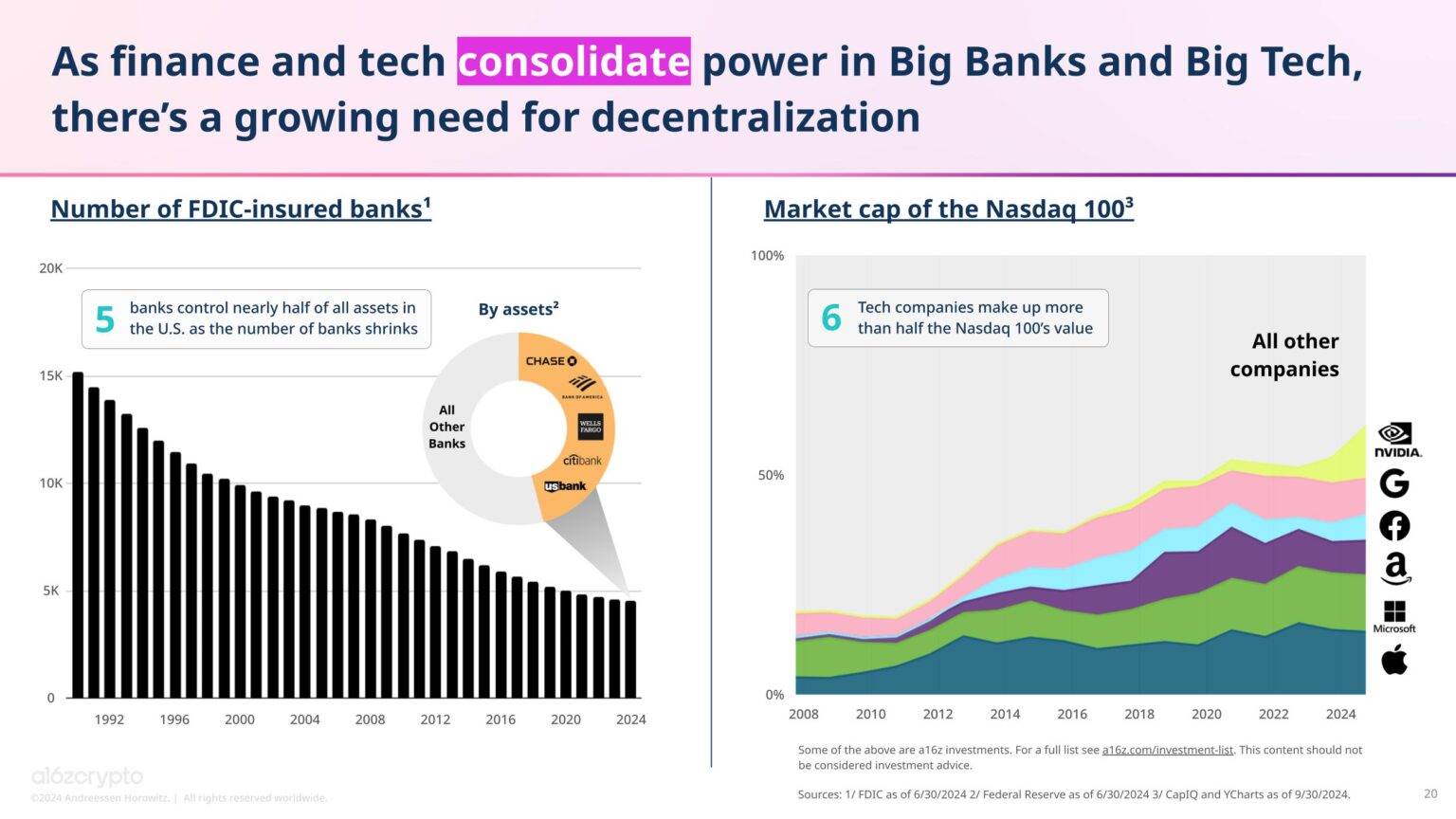
6. Cryptocurrencies may help solve some pressing challenges in AI
Artificial intelligence is one of the hottest trends this year, attracting attention not only in the tech industry but also in the cryptocurrency space.
On social media, AI is one of the topics discussed by cryptocurrency opinion leaders. More surprisingly, there is a significant overlap between users visiting chatgpt.com and those visiting top cryptocurrency websites, indicating a close connection between cryptocurrency and AI users.
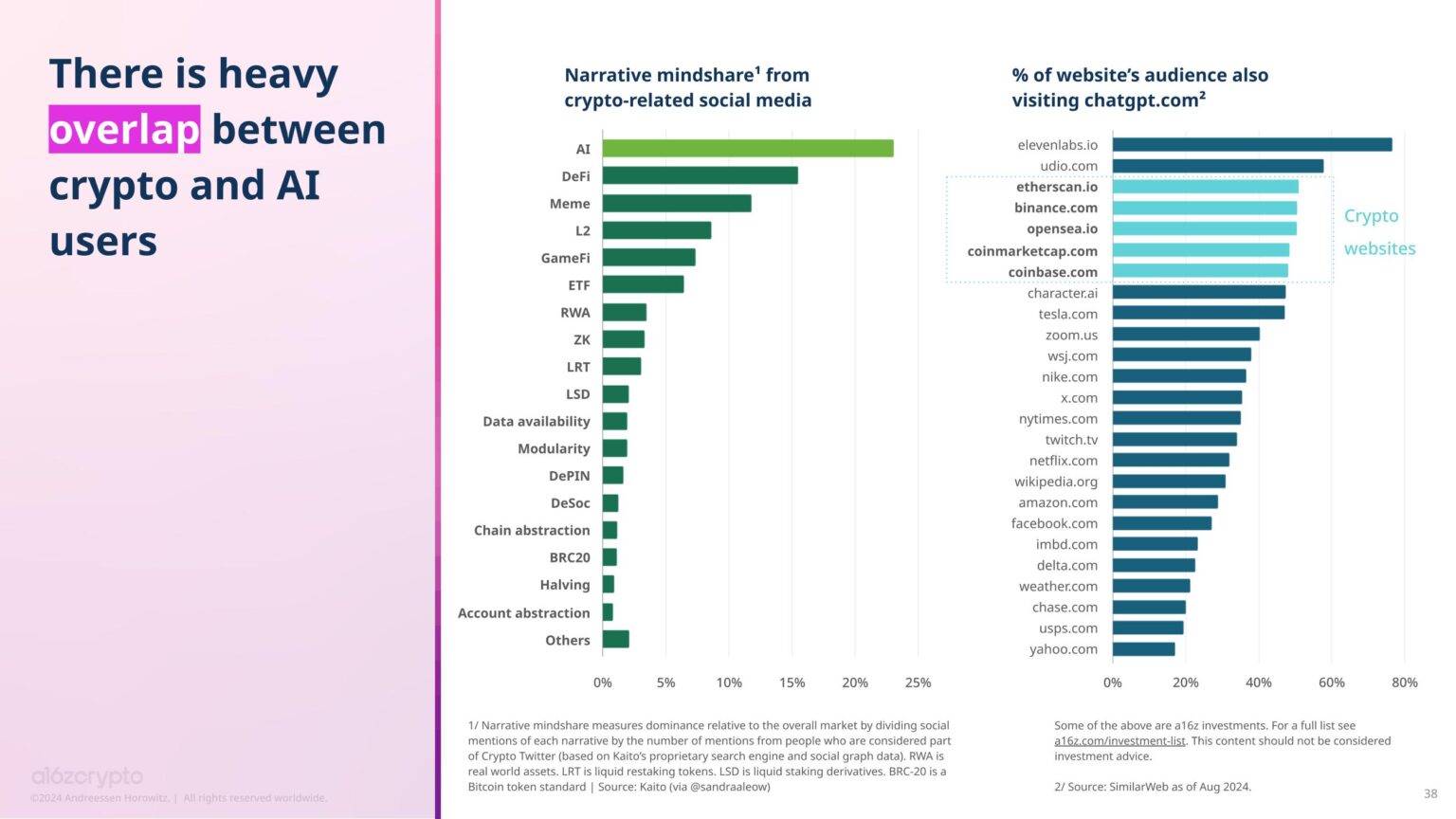
Cryptocurrency developers also have close ties to AI. According to our Developer Energy Dashboard, around 34% of cryptocurrency projects report using AI, up from 27% a year ago. The most common application of AI technology is in blockchain infrastructure projects.
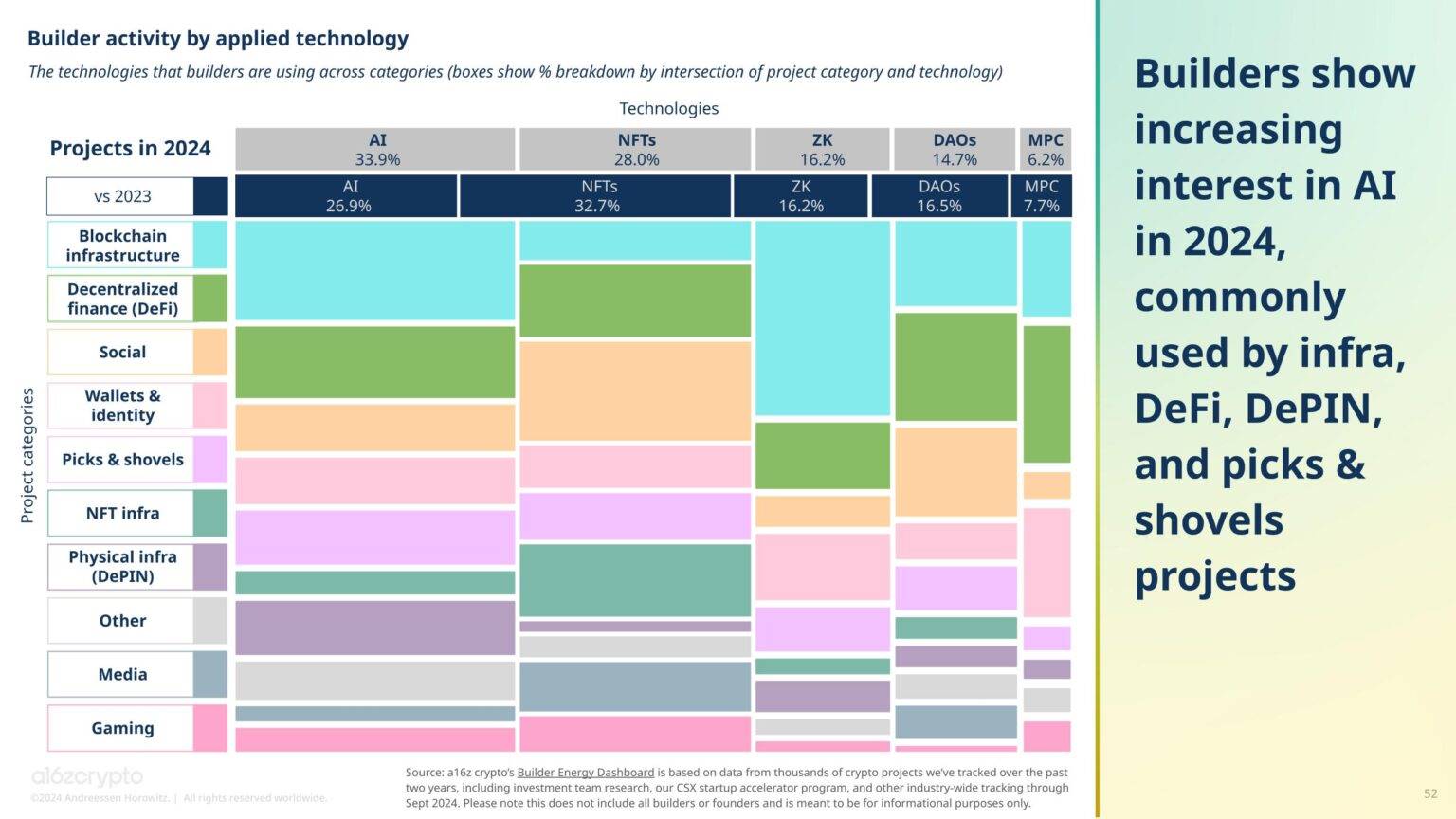
Considering that the cost of training leading-edge AI models has increased fourfold annually over the past decade, we believe AI may lead to further concentration of power on the internet. If left unchecked, only the largest tech companies may have the ability to train the latest AI models.
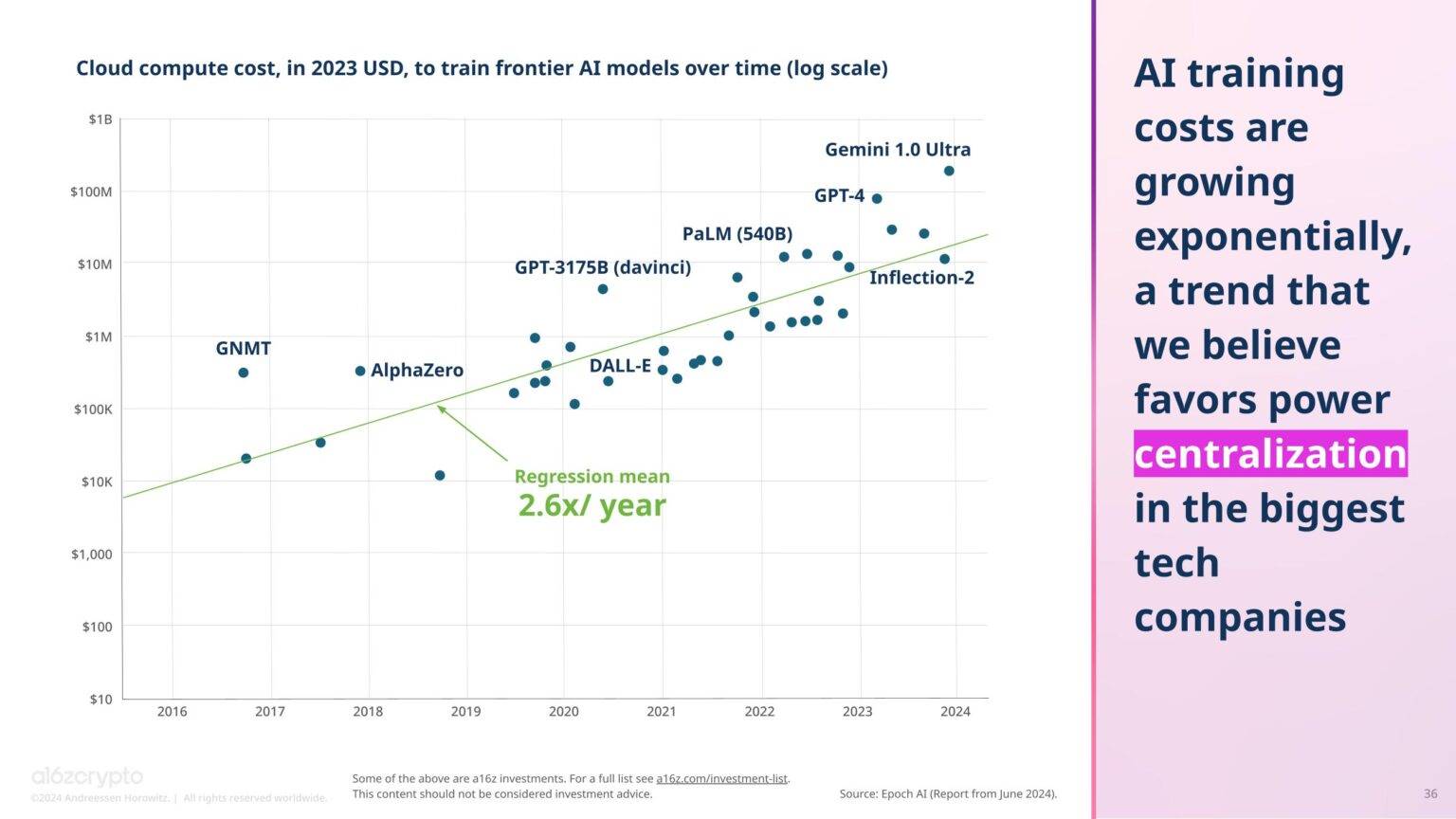
The challenge of AI centralization stands in stark contrast to the decentralization opportunities offered by blockchain networks. Cryptocurrency projects are already working to address these challenges, such as Gensyn democratizing access to AI computing, Story tracking intellectual property to help compensate creators, Near running AI on open, user-owned protocols, and Starling Labs helping to verify the authenticity and provenance of digital media.
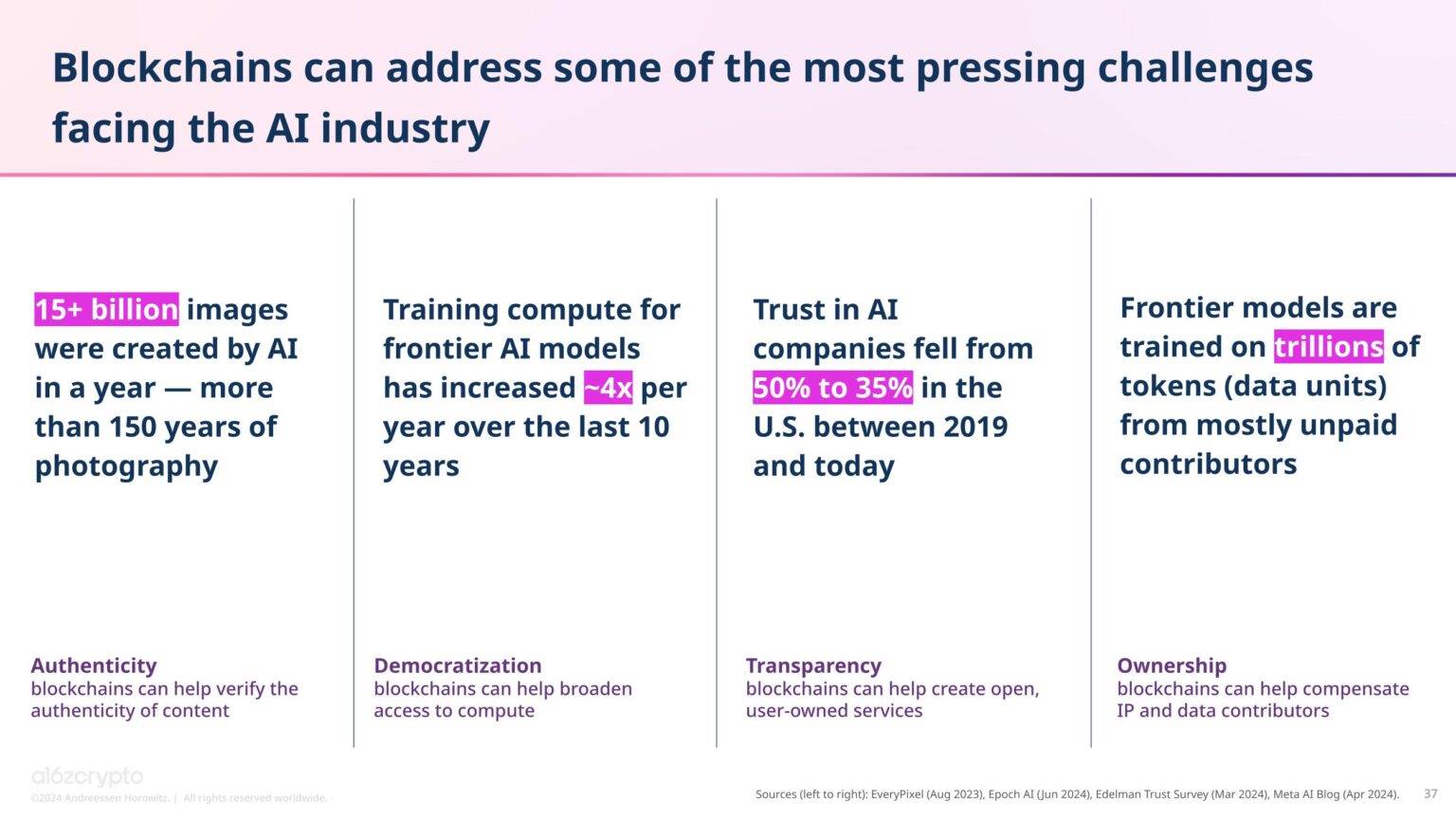
In the coming years, the convergence of cryptocurrencies and AI is likely to deepen further.
7. More efficient infrastructure enables new on-chain applications
With lower transaction costs and increased blockchain capacity, many potential cryptocurrency consumer applications have become possible.
Take Non-Fungible Tokens (NFTs) as an example. A few years ago, due to high cryptocurrency transaction fees, people were trading NFTs in the secondary market for billions of dollars. Now, this phenomenon has subsided, replaced by a new trend of minting low-cost NFT collections on social apps like Zora and Rodeo. This marks a significant shift in the NFT market, which would have been unimaginable before a drastic reduction in transaction fees.
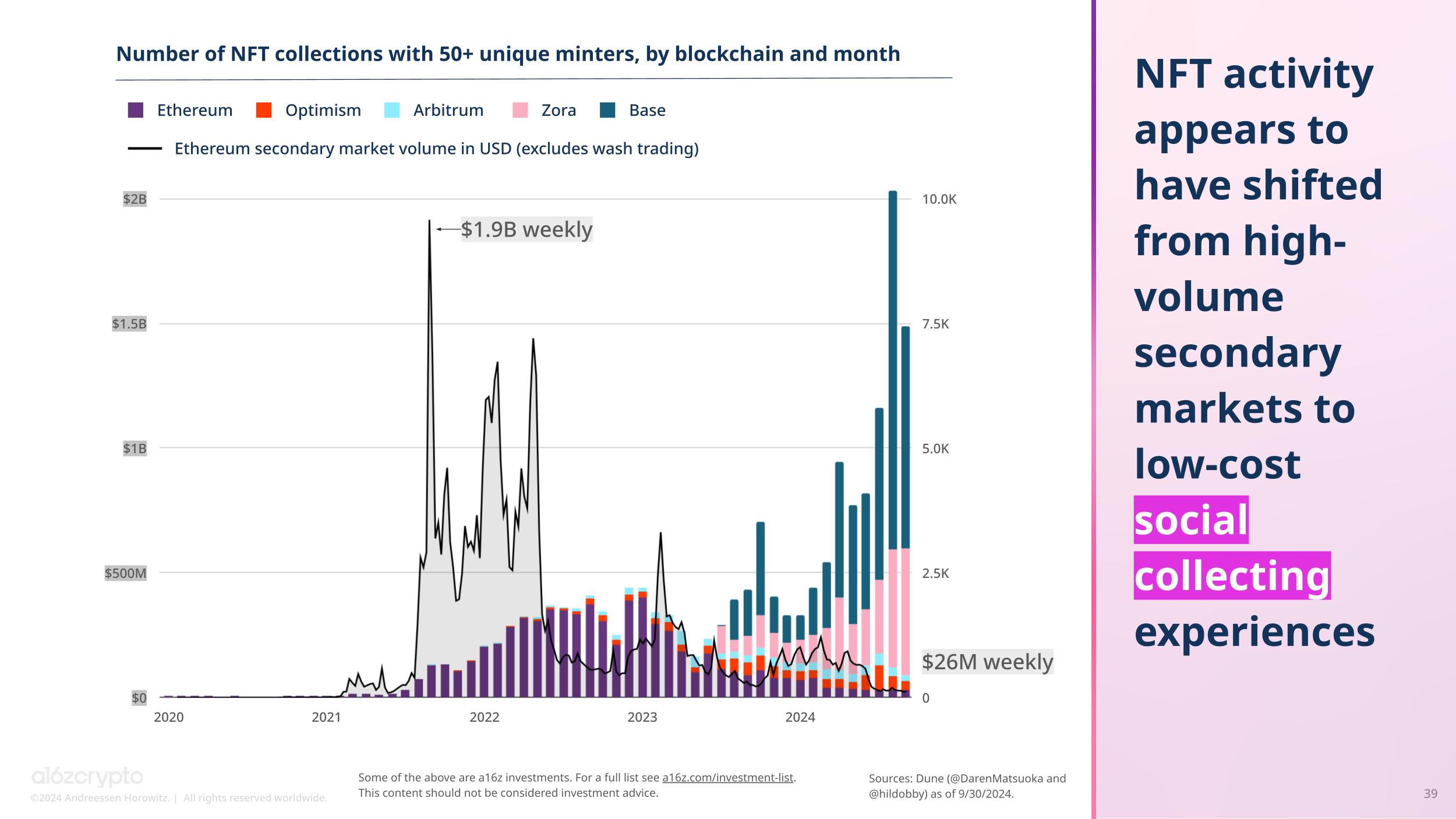
Social networks are another typical example. Although they currently account for a small proportion of daily on-chain activity, they are attracting a significant number of developers: according to our Developer Energy Dashboard, 10.3% of cryptocurrency projects in 2024 will be related to social. In fact, social network-related projects like Farcaster have become one of the hottest developer subcategories this year.
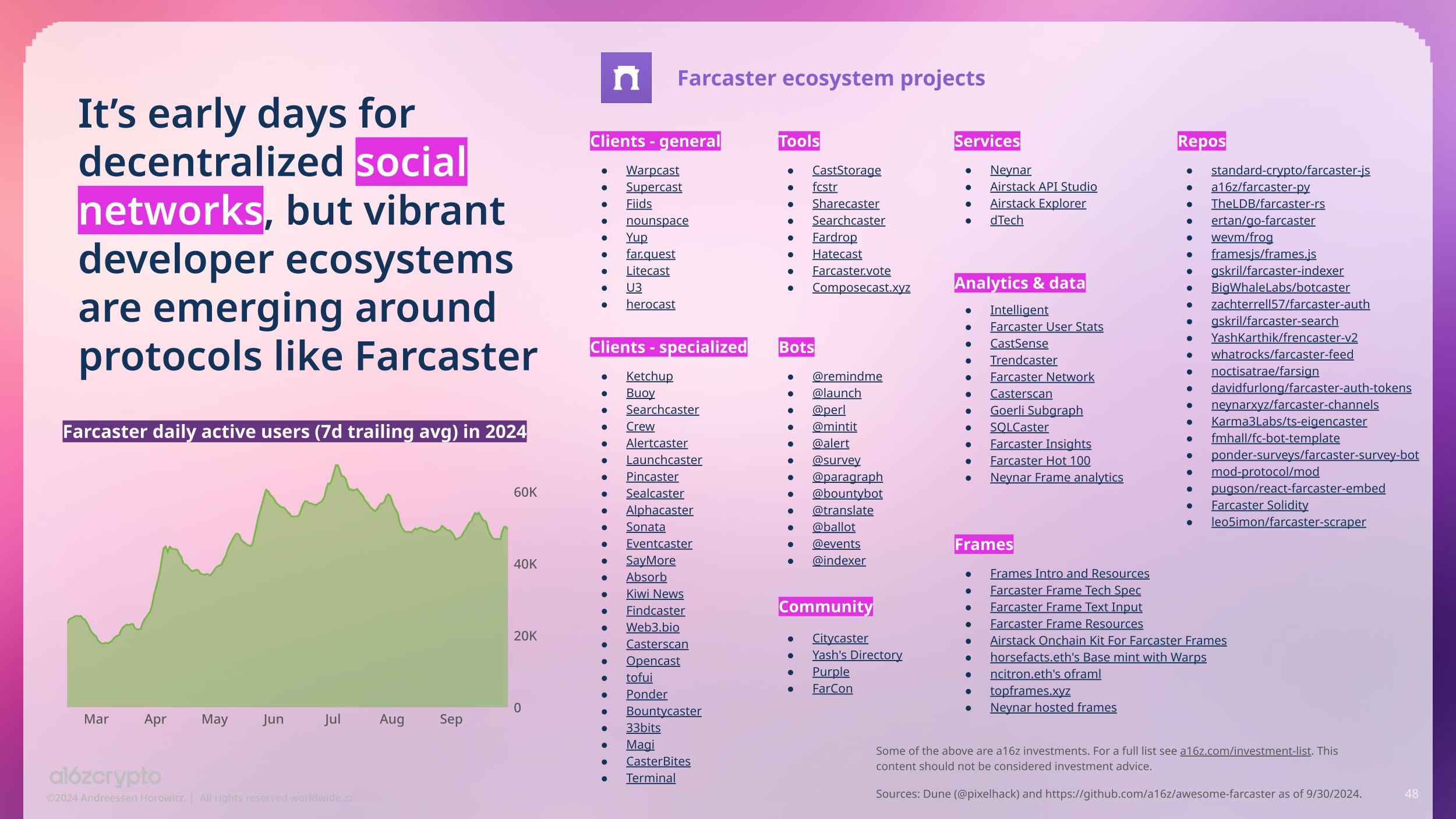
As developers and consumers explore more social experiences, on-chain gaming is pushing the scaling capabilities of blockchains to the limit. For example, the maritime role-playing game Pirate Nation by Proof Of Play, which uses Rollups, has consistently been the highest gas-consuming application on Ethereum.
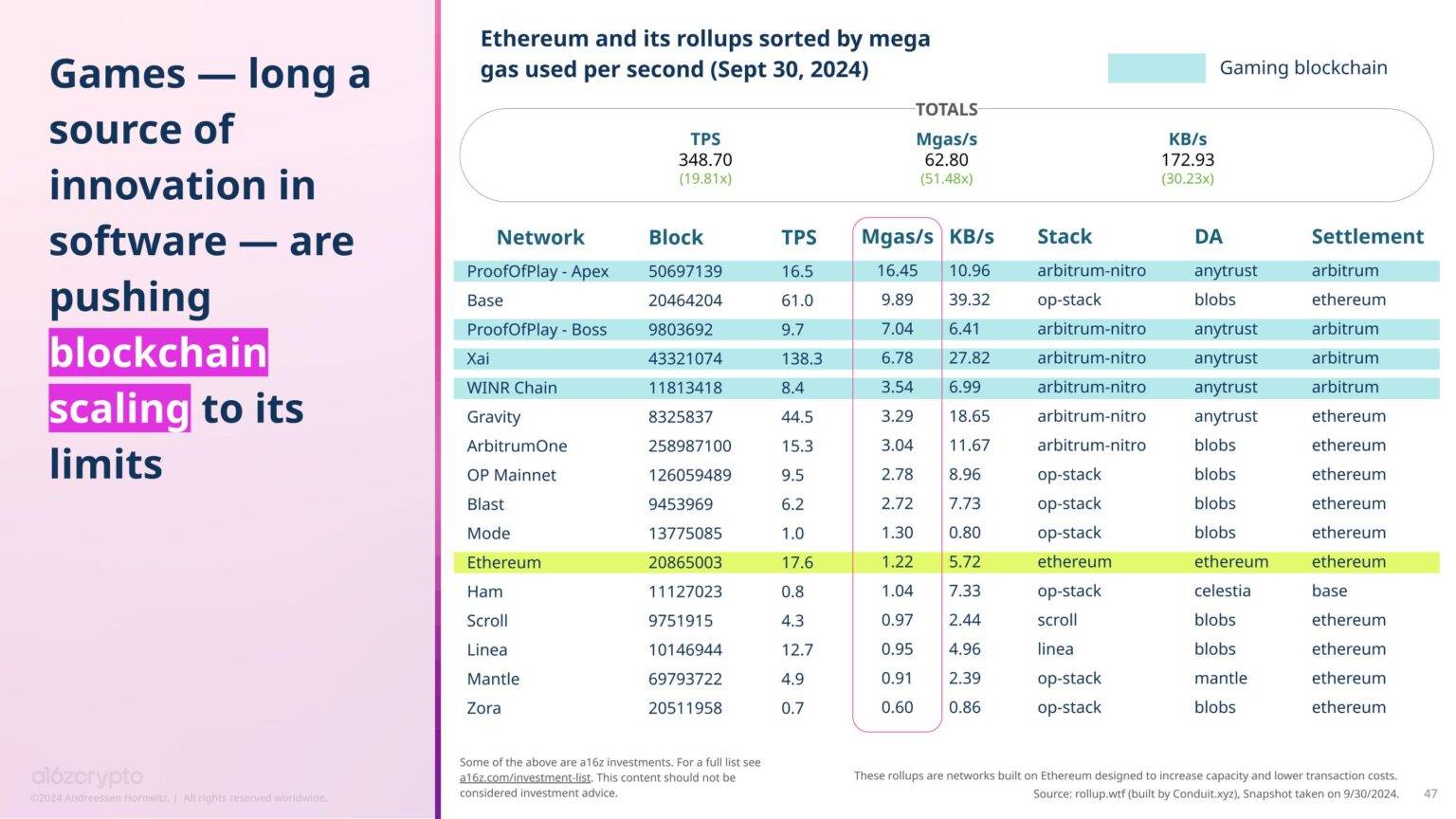
With the upcoming November elections, although cryptocurrency prediction markets remain illegal in the U.S., this area is rapidly developing. Kalshi, a non-cryptocurrency prediction market, has registered with the U.S. Commodity Futures Trading Commission and recently won a lower-court victory in a federal lawsuit over its election contracts. (Currently, registered exchanges are allowed to offer traditional futures contracts based on elections.)
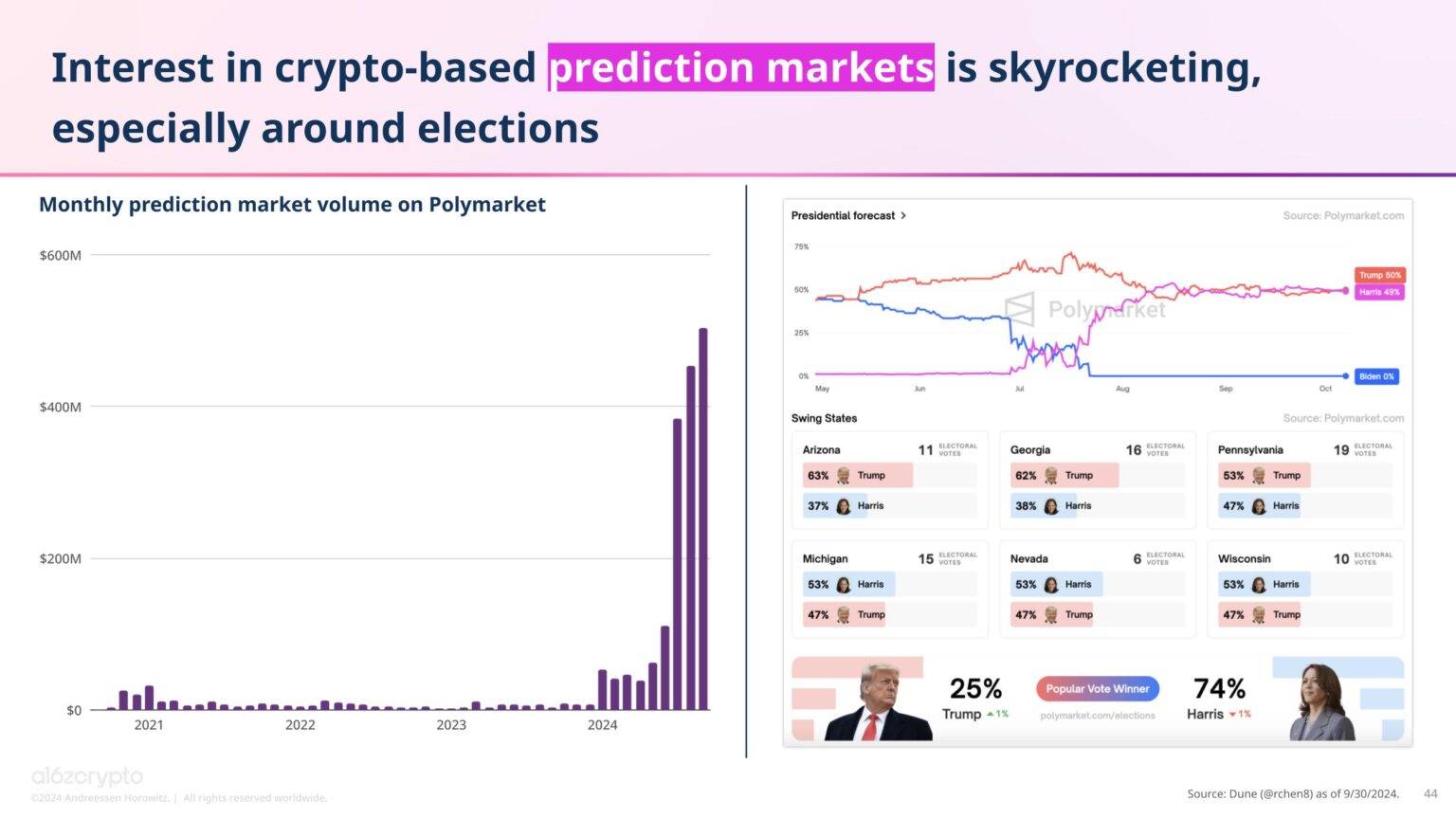
New consumer behaviors are starting to emerge. All these new experiences were difficult to achieve in the past when blockchain infrastructure was cumbersome and transaction costs were high. As blockchain technology continues to improve along the classic price-performance curve, we expect to see more of these applications flourish.
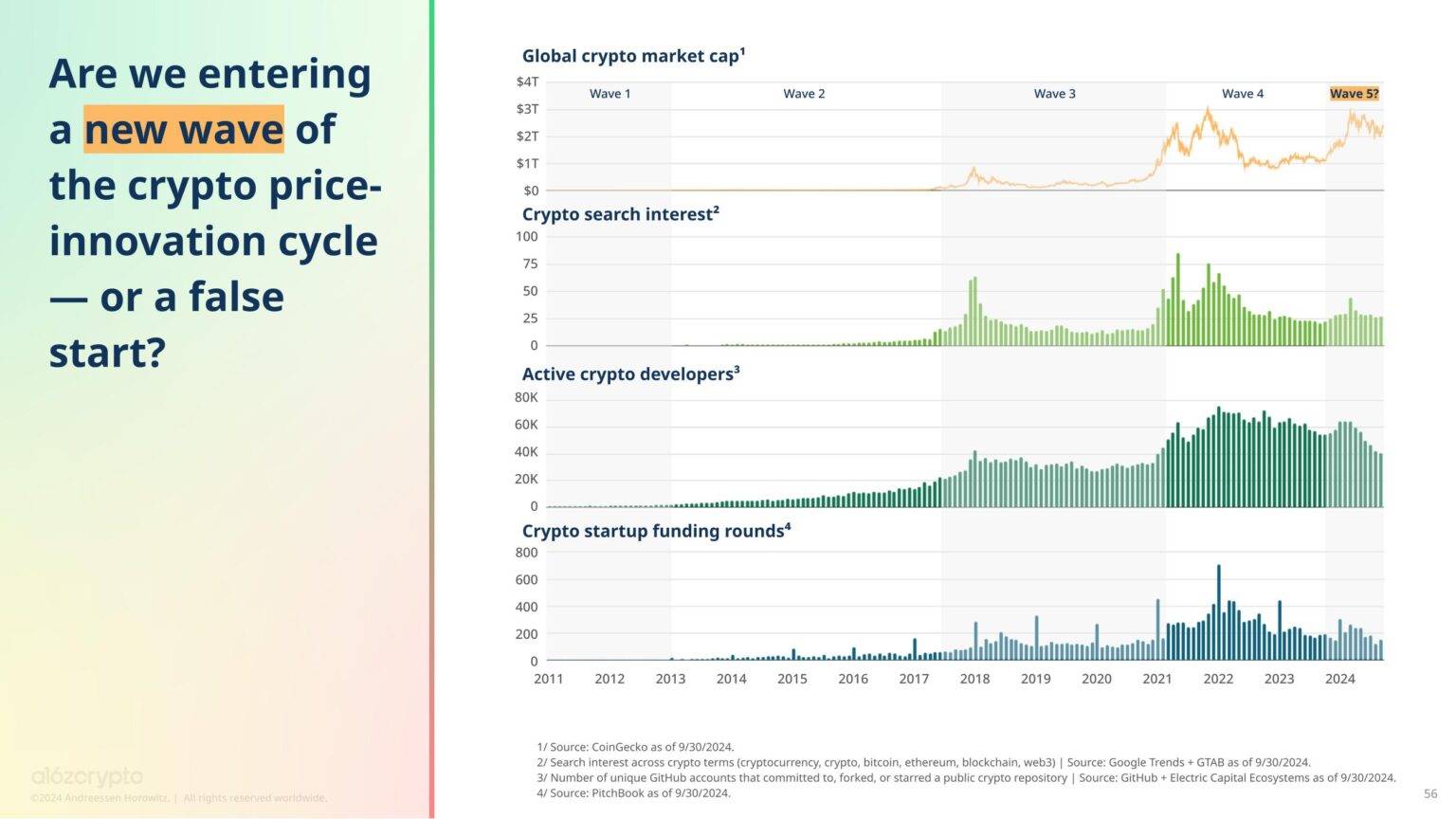
So, where do we stand now? Over the past year, cryptocurrencies have made significant progress in terms of policy, technology, and consumer adoption. On the policy front, there have been multiple milestones, including the sudden approval and listing of Bitcoin and Ethereum ETPs, as well as the passage of important bipartisan cryptocurrency legislation. On the infrastructure side, there have been major improvements, from increased scaling capabilities to the rise of Ethereum L2s and other high-throughput blockchains. Additionally, new applications are being developed and used, from the growth of mainstream products like stablecoins to the exploration of emerging areas like AI, social networks, and gaming.
Whether we have entered the fifth wave of the price-innovation cycle framework that helps us understand the ups and downs of the cryptocurrency market remains to be seen. Nonetheless, as an industry, cryptocurrencies have made undeniable progress over the past year. As demonstrated by ChatGPT, a breakthrough product can change an entire industry.







